|
Postcards from:
Big Bear Lake USA
San Jose Costa Rica
Granada Nicaragua
Managua Nicaragua
San Salvador ElSalvador
Tegucigalpa Honduras
San Pedro Sula Honduras
Copan Ruinas Honduras
La Ceiba Honduras
Utila Island Honduras
La Ceiba Honduras
San Pedro Sula Honduras
Belmopan Belize
Belize City Belize
Orange Walk Belize
Lamanai
Mayan Ruins
Panama City Panama
Bogata Colombia
Cali Colombia
Popayan Colombia
Ipiales Colombia
Quito Ecuador
Galapagos Is. Ecuador
Puerto Ayoro Galapagos
Guayaquil Ecuador
Cuenca Ecuador
Tumbes Peru
Lima Peru
Nazca Peru
Cuzco Peru
Ollantaytambo Peru
Machu Picchu Peru
Machu Picchu Photos
Cuzco Again
Lake Titicaca Peru
Lake Titicaca Photos
Copacabana Bolivia
La Paz Bolivia
Arica Chile
Iquique Chile
Antofagasta Chile
Santiago Chile 1
Valparaiso Chile
Santiago Chile 2
Easter Island Chile
Santiago Chile 3
Chillan Chile
Valdivia Chile
Puerto Montt Chile
Castro Chile
Chaiten Chile
Coyhaique Chile
Puerto Chacabuco Chile
Coyhaique Chile
Punta Arenas Chile
Puerto Natales Chile
Punta Arenas Chile
Puerto Williams Chile
Ushuaia Argentina
Buenos Aires Argentina
Puerto Iguazu Argentina
Montevideo Uruguay
Colonia Uraguay
Caracas Venezuela
Ciudad Bolivar Venezuela
Puerto Ordaz Venezuela
Porlamar Venezuela
PortOSpain Trinidad
Georgetown Guyana
Corriverton Guyana
Paramaribo Suriname
Cayenne French Guiana
Pointa A Pitre Guadaloupe
Gosier Guadeloupe
Dominican Republic
Miami Florida
Back Home in California
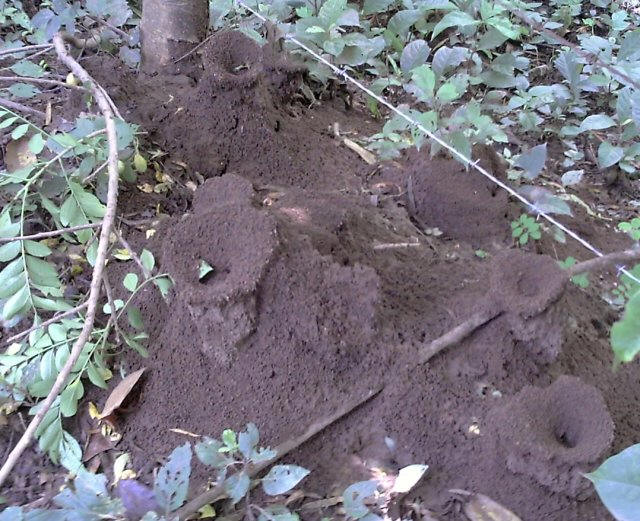
Coppan Ruinas Honduras:
Interesting ant hills in the
Las Sepulturas
archaeological ruins area.
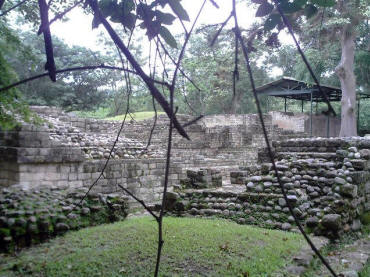
Coppan Ruinas Honduras: One of the structures in the Las Sepulturas
archaeological ruins area.
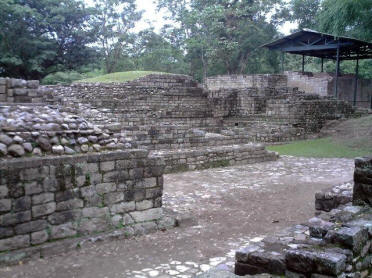
Coppan Ruinas Honduras: One of the structures in the Las Sepulturas
archaeological ruins area.
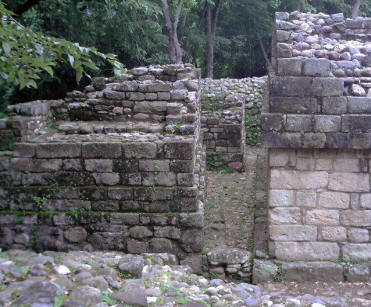
Coppan Ruinas Honduras: One of the structures in the Las Sepulturas
archaeological ruins area.
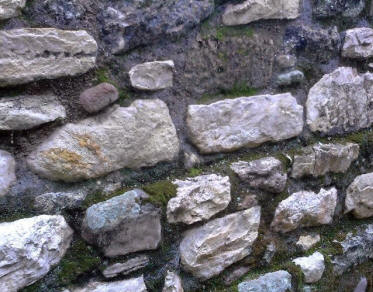
Coppan Ruinas Honduras: Close up of stone work used by the ancients at
the Las Sepulturas archaeological ruins area.
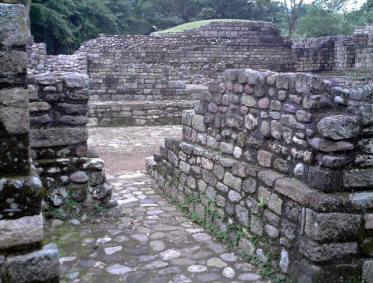
Coppan Ruinas Honduras: One of the structures in the Las Sepulturas
archaeological ruins area.
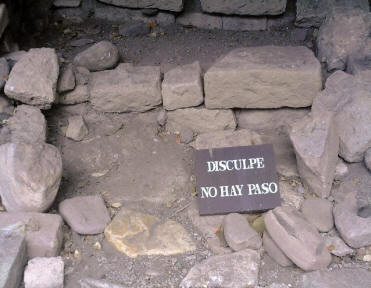
Coppan Ruinas Honduras: Sign along the path in the Las Sepulturas
archaeological ruins area.
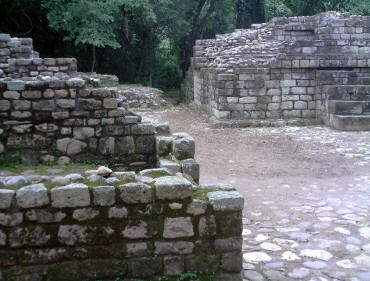
Coppan Ruinas Honduras: One of the structures in the Las Sepulturas
archaeological ruins area.
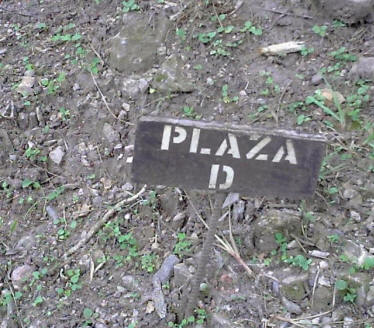
Coppan Ruinas Honduras: Sign designating one of the structures in the
Las Sepulturas archaeological ruins area.
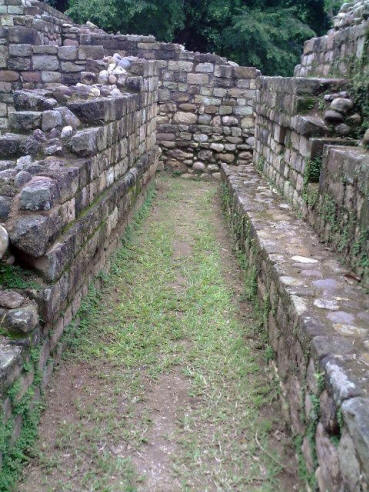
Coppan Ruinas Honduras: One of the structures in the Las Sepulturas
archaeological ruins area.

Coppan Ruinas Honduras: One of the structures in the Las Sepulturas
archaeological ruins area.
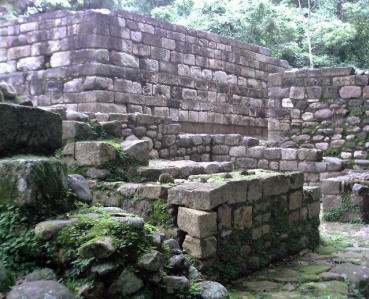
Coppan Ruinas Honduras: One of the structures in the Las Sepulturas
archaeological ruins area.

Coppan Ruinas Honduras: Sign along the foot path in the Las Sepulturas
archaeological ruins area.
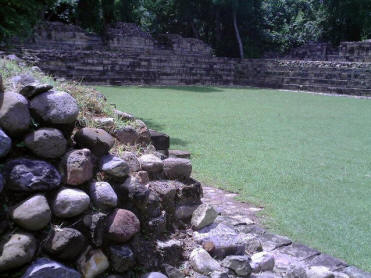
Coppan Ruinas Honduras: One of the structures in the Las Sepulturas
archaeological ruins area.
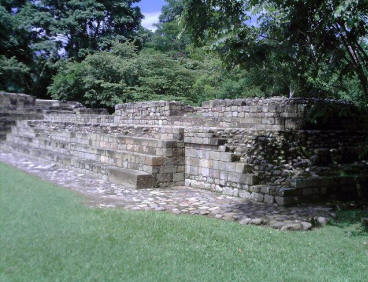
Coppan Ruinas Honduras: One of the structures in the Las Sepulturas
archaeological ruins area.
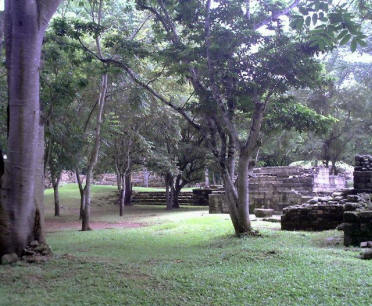
Coppan Ruinas Honduras: Mosquito ally through the Las Sepulturas
archaeological ruins area.
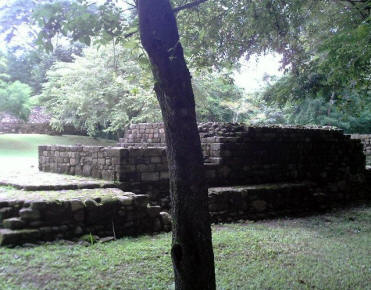
Coppan Ruinas Honduras: One of the structures in the Las Sepulturas
archaeological ruins area.
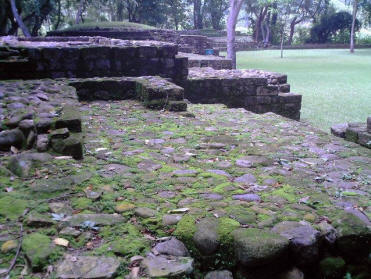
Coppan Ruinas Honduras: One of the structures in the Las Sepulturas
archaeological ruins area.
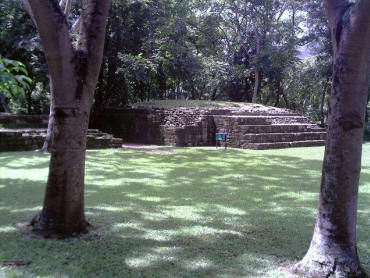
Coppan Ruinas Honduras: One of the structures in the Las Sepulturas
archaeological ruins area.
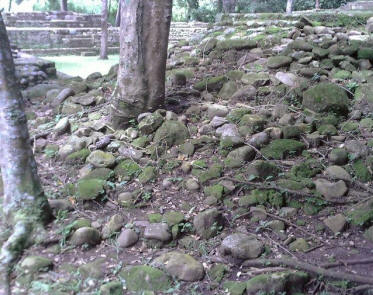
Coppan Ruinas Honduras: What archaeologists found when they first
visited the Las Sepulturas archaeological ruins area.
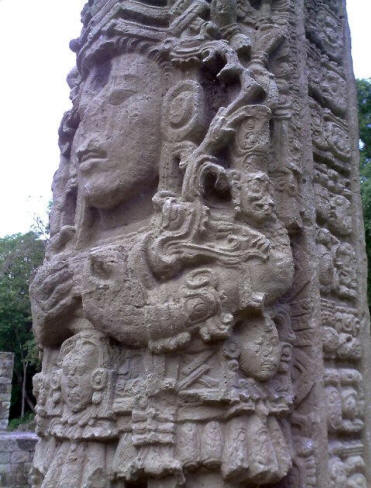
COPAN RUINAS: Details of one of the best preserved Stellae (Estela) in
the main archaeological ruins area.
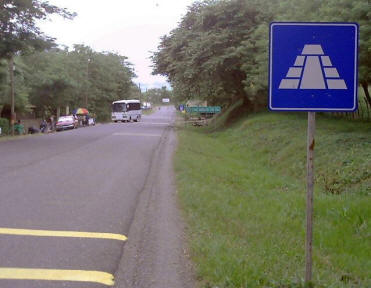
COPAN RUINAS: This is the paved foot path that connects the town to the
archaeological park about a mile away... a very pleasant stroll through
green pastures and shady trees.
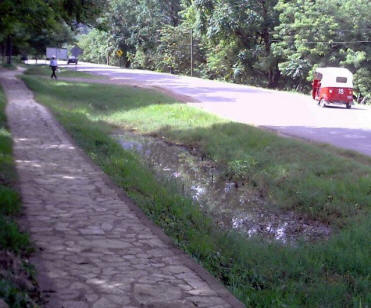
COPAN RUINAS: This is the paved foot path that connects the town to the
archaeological park about a mile away... a very pleasant stroll through
green pastures and shady trees.
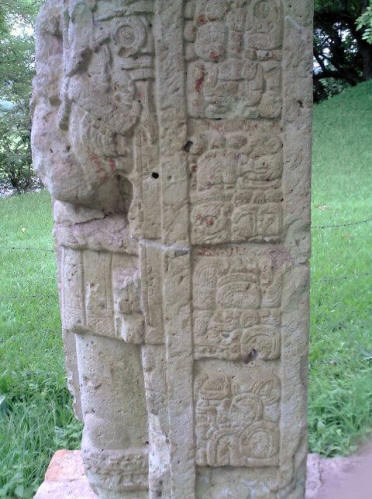
COPAN RUINAS: Along the paved foot path there are several estela like
this as well as many unexcavated mounds covering more ruins.
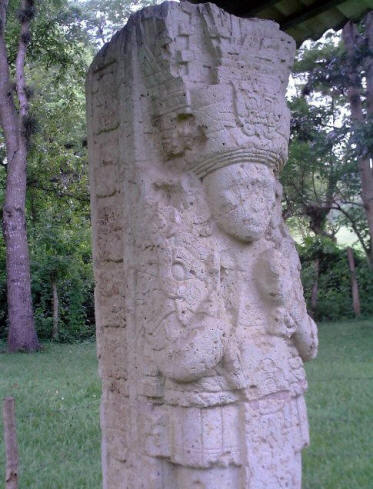
COPAN RUINAS: Along the paved foot path there are several estela like
this as well as many unexcavated mounds covering more ruins.
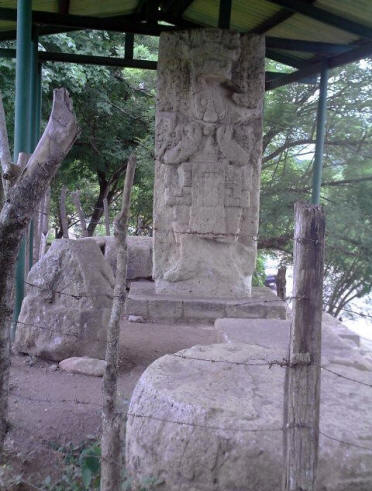
COPAN RUINAS: Along the paved foot path there are several estela like
this as well as many unexcavated mounds covering more ruins.
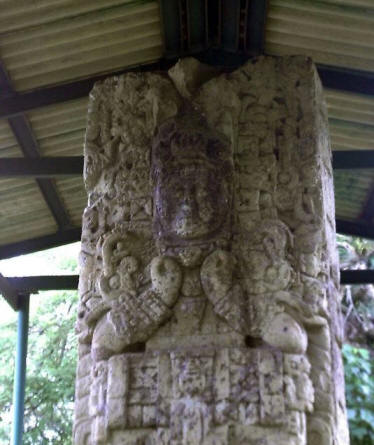
COPAN RUINAS: Along the paved foot path there are several estela like
this as well as many unexcavated mounds covering more ruins.
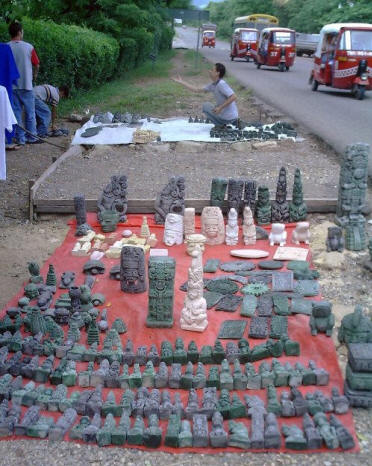
COPAN RUINAS: Display of things being offered by vendors at the entrance
to the archaeological park.
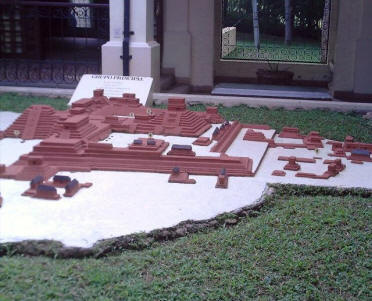
COPAN RUINAS: Miniature display of the layout of the ruins. It is
located near the ticket sellers booth. Another angle.
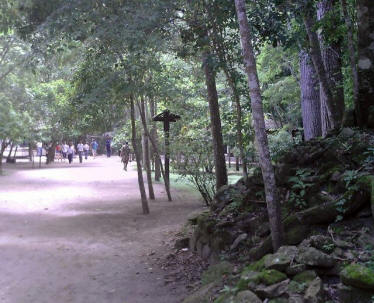
COPAN RUINAS: The path to the ruins meanders along 400 meters through a
lovely landscaped jungle setting.

COPAN RUINAS: Miniature display of the layout of the ruins. It is located
near the ticket sellers booth. Entrance to the park is $10/day.
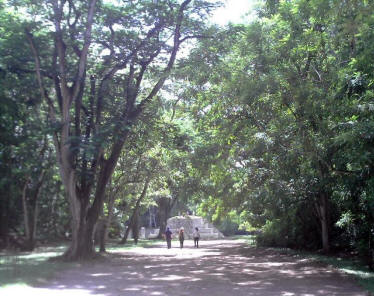
COPAN RUINAS: Inside the gated fence this is my first glimpse of the
ruins.
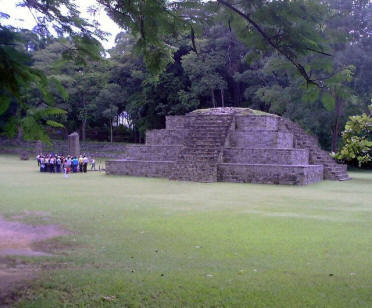
COPAN RUINAS: Inside the gated fence this is the first major group of
structures we see of the ruins.
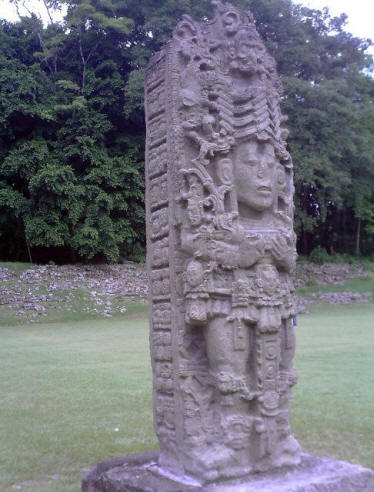
COPAN RUINAS: One of the major stelae in the main section of Copan
Ruinas.
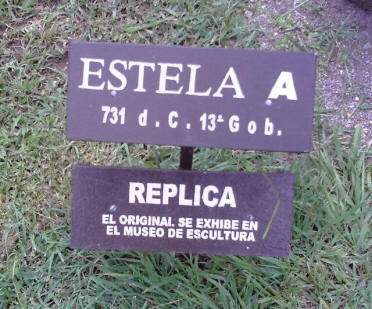
COPAN RUINAS: Sign next to one of the major stelae in the main section
of Copan Ruinas.
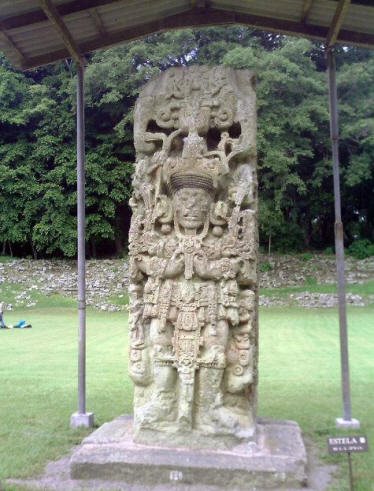
COPAN RUINAS: One of the major stelae in the main section of Copan
Ruinas.
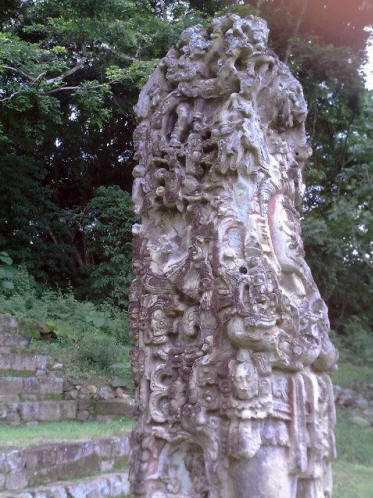
COPAN RUINAS: One of the major stelae in the main section of Copan
Ruinas.

COPAN RUINAS: One of the major stelae in the main section of Copan
Ruinas.
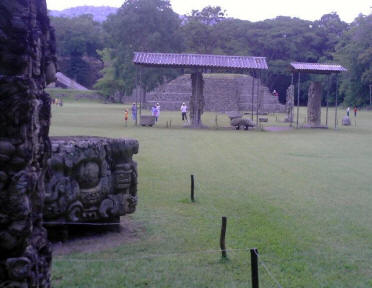
COPAN RUINAS: One of the major stelae in the main section of Copan
Ruinas.

COPAN RUINAS: Sign for Altar G1 in the main section of Copan Ruinas.
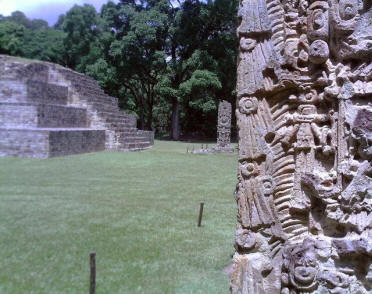
COPAN RUINAS: One of the major stelae in the main section of Copan
Ruinas.
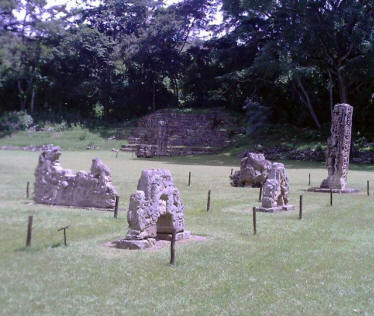
COPAN RUINAS: A grouping of structures in the main section of Copan
Ruinas.
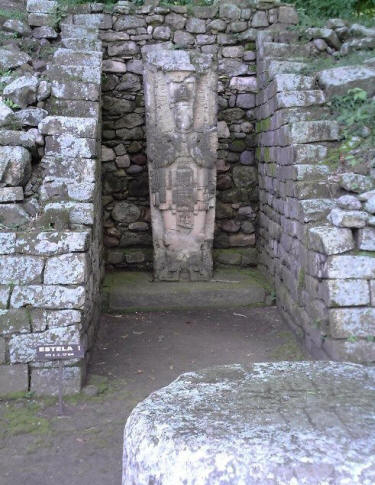
COPAN RUINAS: One of the major stelae in the main section of Copan
Ruinas.
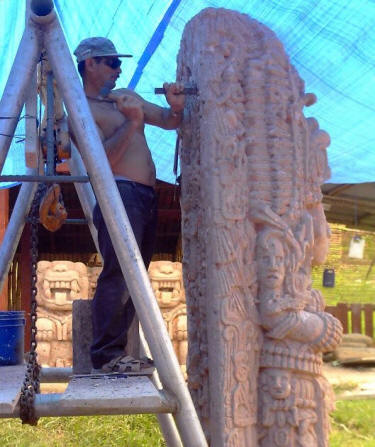
COPAN RUINAS: This stone sculpture workshop sits across the street from
the entrance to the main archaeological park. Here we see one of the
artists at work.

COPAN RUINAS: Sculpture of the "Corn God" on display in the Copan
Archaeological Museum in the Parque Central.
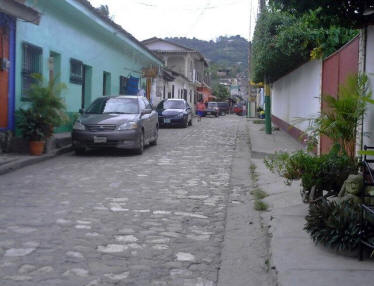
COPAN RUINAS: Continuation of the street that runs along the south side
of the plaza.
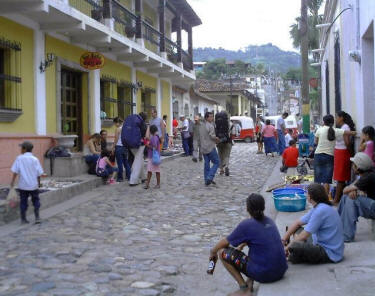
COPAN RUINAS: Continuation of the street that runs along the west side
of the plaza. This block is the main commercial area for tourists and
always has sidewalk vendors selling crafts favored by the backpacking
crowd.
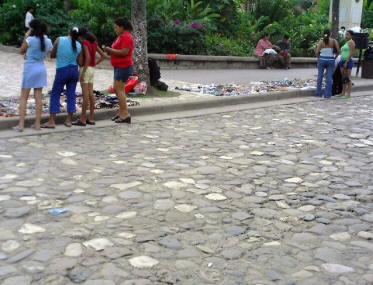
COPAN RUINAS: This is the street that runs along the east side of the
plaza. Here too we have sidewalk vendors selling crafts. Notice the
cobblestone road paving used throughout the town.
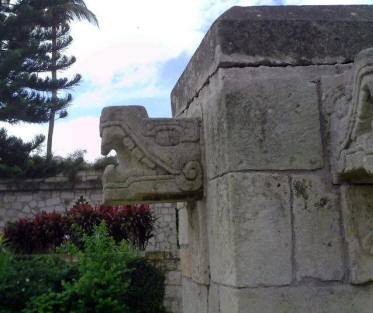
COPAN RUINAS: One of the replica sculptures in the central Plaza.
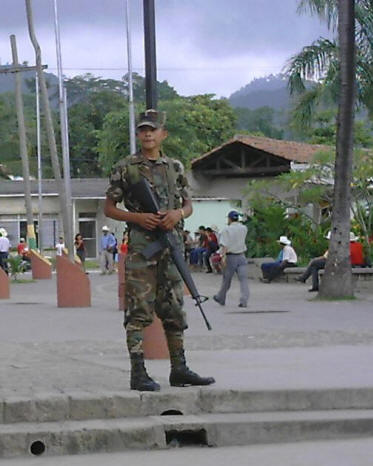
COPAN RUINAS: Armed National Policeman guards the central Plaza.

COPAN RUINAS: The Copan Archaeological Museum sits on the west side of
the central plaza. This is the entrance.
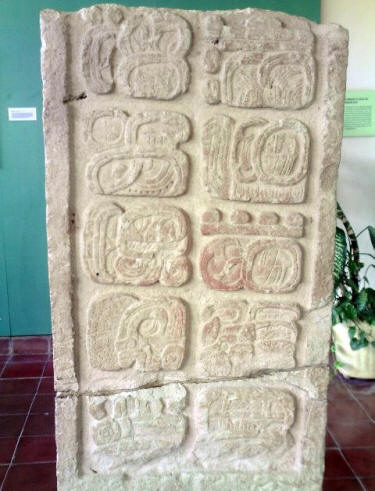
COPAN RUINAS: Stelae from the near-by ruins on display in the Copan
Archaeological Museum in the Parque Central.
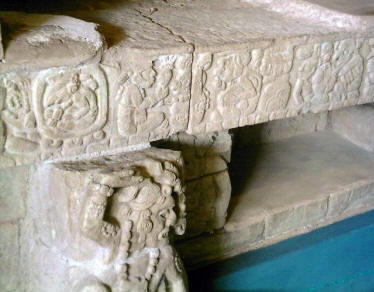
COPAN RUINAS: Sculpture from the near-by ruins on display in the Copan
Archaeological Museum in the Parque Central.
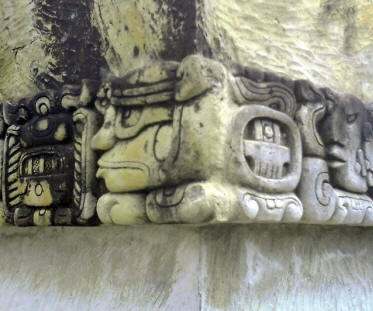
COPAN RUINAS: One of the sculptures in the central Plaza.
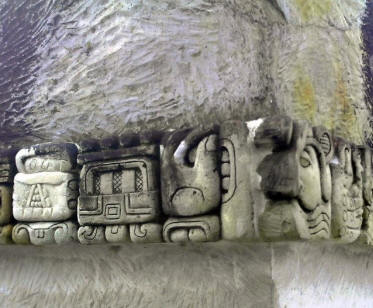
COPAN RUINAS: One of the sculptures in the central Plaza.
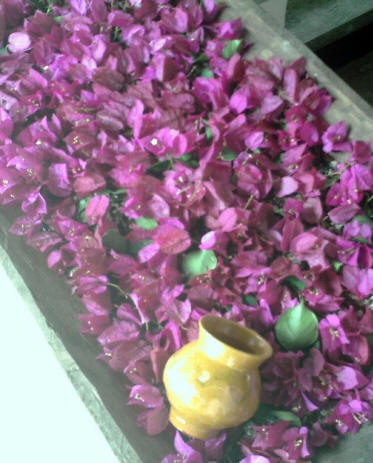
COPAN RUINAS: A delightful display of Bougainville blossoms at the Hotel
Marina Copan.
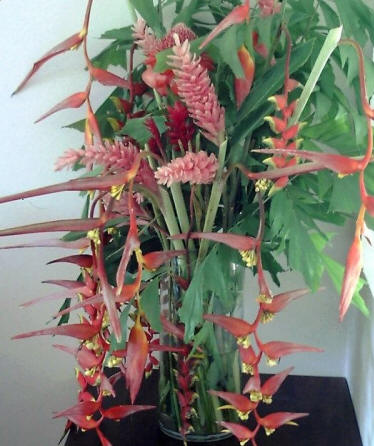
COPAN RUINAS: They rebuild these gorgeous floral displays every few days
at the Hotel Marina Copan.
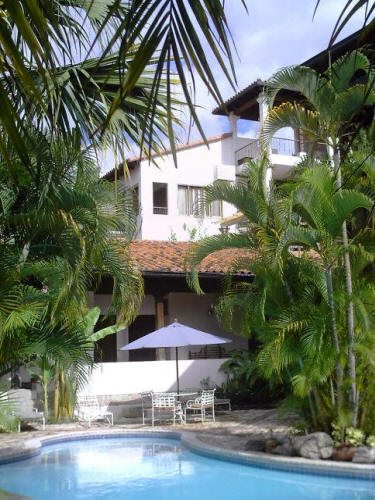
COPAN RUINAS: A view of the pool area at the Hotel Marina Copan.
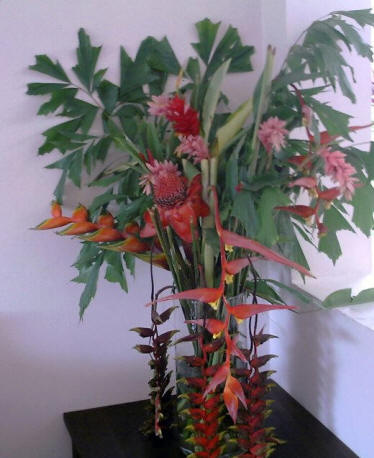
COPAN RUINAS: One of the elaborate floral displays at the Hotel Marina
Copan.
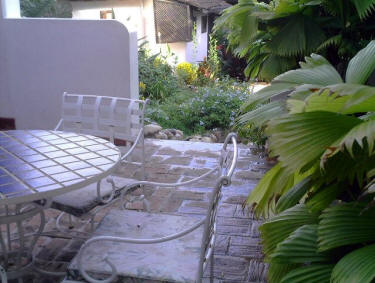
COPAN RUINAS: A view of a landscaped area at the Hotel Marina Copan.
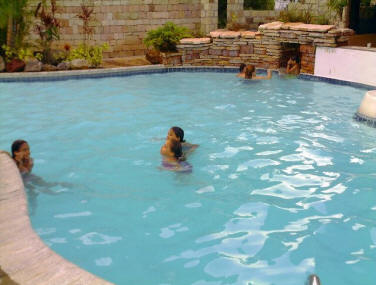
COPAN RUINAS: A view of the pool area at the Hotel Marina Copan.
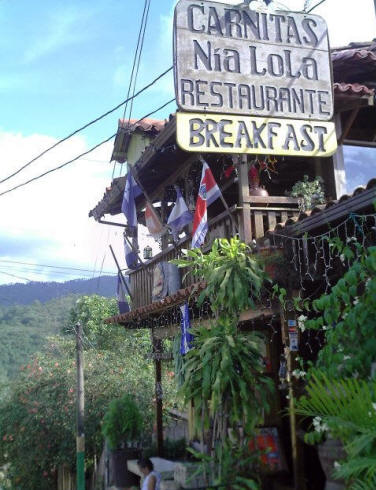
COPAN RUINAS: One of the more popular restaurants in town favored by the
backpacker crowd. It is famous for the waitresses who balance food on
their heads on their way to guest�s tables.
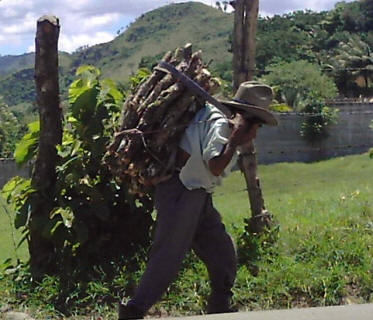
COPAN RUINAS: The old wood cutter; notice his machete.
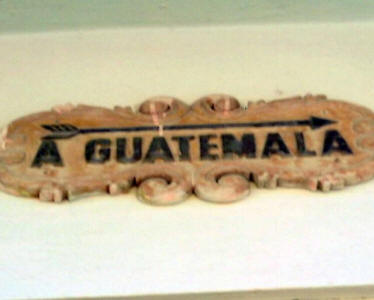
COPAN RUINAS: This sign shows Copan is only 17 miles from the Guatamalan
border. The road out of town runs by the cemetery.
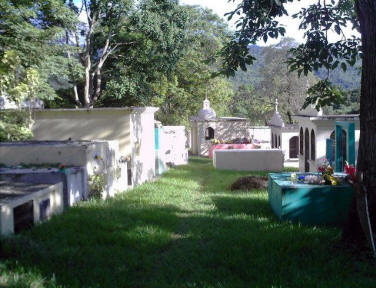
COPAN RUINAS: High rent district in the main city cemetery.
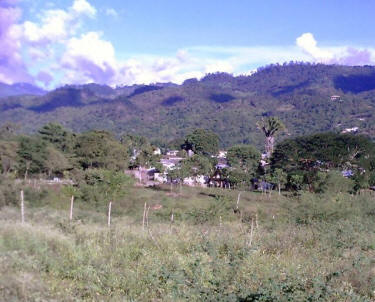
COPAN RUINAS: Outside the city looking east toward the center of town.

COPAN RUINAS: I found this vigorously growing thicket of SARSA plants
growing outside town near a corn field. A ground cover variety called
Sarsa Dormilona appears identical to a plant I discovered in Malasia and
Indonesia. The leaves when touched, shrivel up.

COPAN RUINAS: Outside the city on the south side stands this sign
showing the distance to nearby places.
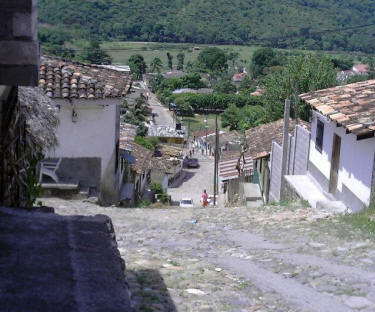
COPAN RUINAS: Some of the streets in this hilly town are so steep few
ordinary cars would be able to climb them. See the same street from the
other end in the next photo.
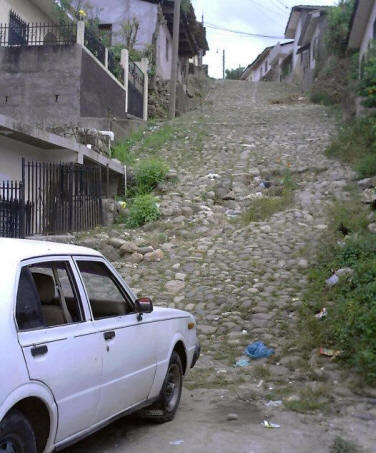
COPAN RUINAS: This is the other end of the street shown in the previous
picture. Obviously, few vehicles attempt to climb this "cliff."
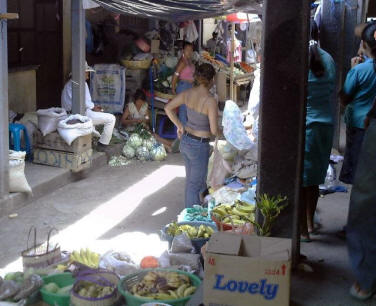
COPAN RUINAS: Inside the Mercado Central behind the west side of the
plaza.

COPAN RUINAS: Some of the unusual plants used to landscape the central
plaza, Parque Central.

COPAN RUINAS: Many of the older structures are constructed of adobe
bricks like this one.
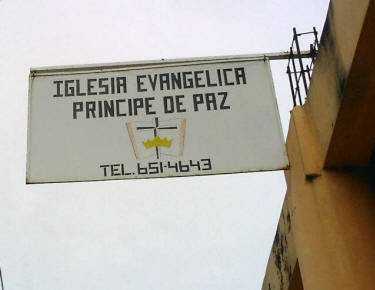
COPAN RUINAS: I captured this picture as a reminder to mention all of
the evangelical activity that has been focused on Central America by
American Bible belt denominations.
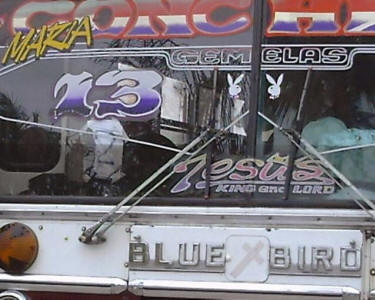
COPAN RUINAS: Religious decorations on one of the public buses. This
sort of "advertising" is not uncommon here.
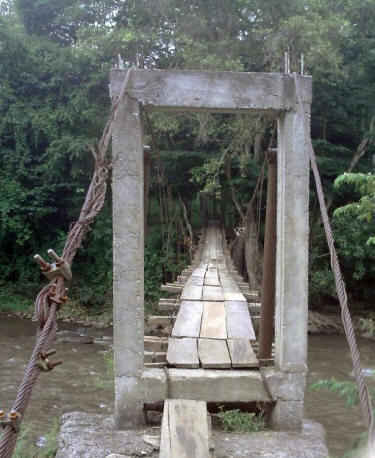
COPAN RUINAS: Hanging foot bridge across a river near the El Jaral water
park and "mall."
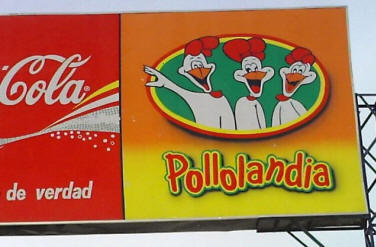
COPAN RUINAS: Even
Honduras has its share of happy chickens selling their cooked brothers and
sisters.
|
  8 August 2005 8 August 2005
Bienvenidos from the Mayan ruins of Copan Honduras,
Copan Ruinas
is a comfortable three hour ride down good roads from San Pedro Sula. I saw little traffic in either lane during our mid-day trip. The Hedman Alas super deluxe bus passed through some of the most continuously green parts of this world I have ever enjoyed. It seems like everything is shrouded in green here; jungles, pastures, gardens, some parts of the highway pass through leafy tunnels of green. Along the way gauchos in cowboy style hats with their horses made me think of the American old west. Most men carry machetes; some carry pistols. The machetes are used for everything, but defense. Lawns are ¨mowed¨ with them; fire wood is cut with them; nails are pounded with them; structures are built with them, heavy loads are carried with them and they make it easy to tell the men from the women who rarely carry them.
We arrived on the outskirts of Copan shortly after lunchtime and I immediately started my exploration of the city which in this case sits on the side of a steep hill about half a kilometer from the bus terminal. Dogs lazed about and men walked their horses or trudged up the hill slowly carrying loads of firewood cut with those long machetes hanging from their belts. In all of my nine days in Copan Ruinas only once did I hear a dog bark and then only briefly. That took me back to my days in Africa where dogs don't bark either.
Colorful butterflies flit from one place to another; reds, yellows, strips, iridescent greens and violet, blacks, beautiful. I must wonder if the mosquitoes harass the butterflies as much as they do tourists. That would explains their erratic flight behavior. There sure are a lot of mosquitoes here. I have been bitten as many as ten times in one day. The cyber cafes are the worst as my attention is focused on work and the little sneaks have time to dig in before arousing my awareness that something is amiss.
Other than the armed uniformed national police who hang around the central plaza and the private security guards hired by the banks, I have seen very little in the way of security personnel anywhere in or around town. This little tourist town has a deserved reputation for being very safe for foreign visitors. People on the street always smile, greeting strangers either in Spanish or English and they good naturedly return my greetings delivered in broken Spanish. While there are a few automobile taxis around town, most people use the ubiquitous Mototaxis, little three wheel motorbikes with covered passenger compartments seating three tightly packed teenagers plus someone sharing the driver's seat in a pinch. The fare is 10 Lempiras per person from anywhere to anywhere, as long as you are willing to occasionally tolerate being packed like sardines in the cramped enclosure. No ride is more than a few minutes in duration, so for fifty cents no one complains.
I am really enjoying this old Spanish colonial town and the totally wonderful deluxe hotel I found. Why it is named Hotel Marina Copan I never learned; there certainly is no large body of water nearby. At this time of year the river is shallow enough to wade across, though I did see fishermen out in the middle casting nets with the water up to their chests. At first quoted the rack rate of $75 plus tax, I asked about promotional rates and the assistant manager, Miguel noted he could drop the rate to $51 if I were going to stay a week or more. Though I wouldn´t guarantee such a long stay, he still gave me the lower rate... and after my less than enthusiastic first night in the dark dungeon of an authentically old colonial room I'd initially been assigned, he upgraded me to one of the modern rooms in the hotel's newest structure. It pays to ask. When I went to check out nine days later I learned he had further reduced my daily rate to $45!
The best restaurant in town clearly is the one in the hotel; air conditioned, modern, with a full range of excellent food from typical Honduran to familiar Western. My first morning I chose Huevo Marinita (Mama´s recipe): homemade tomato sauce over fried egg, ham slice, tortilla, cheese with a large glass of freshly squeezed orange juice and some of the country's excellent coffee, all for about $4.
After a few days of getting oriented and locating the cyber cafes, I finally made the short hike over to the archaeological park. The grass along the kilometer long flagstone foot path had recently been cut and the smell mingled with the odors of farm animals. New mowed grass smells a bit different here... more vegetable, earthy. At several places fence posts have taken root and sprouted new growth, some having done so long ago are now full grown trees. I now suspect the long rows of trees I saw on distant hills coming down from San Pedro Sula may have started off as mere fence posts delineating property lines many years ago.
Copan
Ruinas displays an amazing
record of
the ancient Mayan culture
and society. The sculpture
museum
near the entrance to the ruins is being renovated so is closed to
visitors at the moment. The $10 entrance fee includes free admission
to a second site a mile down the road: Las Sepulturas, which seems
to be the ruins of a residential area for the Mayan elite in ancient
Copan. Less
well developed, in many ways it is a more authentic indication of
the actual antiquity. Lush vegetation creates pleasant shady paths
connecting the several collections of partially excavated ruins. It
also creates a perfect habitat for swarms of aggressive mosquitoes,
many of which showed me how much they enjoyed my visit. While
swatting mosquitoes and watching a kaleidoscope of butterfly
formations, a pair of birds on opposite sides of a grassy clearing
performed a perfectly harmonized and syncopated duet lasting at
least five minutes. For a brief period I believed the beautiful
jungle concert to be the work of human musicians. Entranced by the
rain forest ballet I overlooked another performance at my feet for a
while. An unusual plant locally called "Sarsa" shyly retreats
when anything makes contact with it's feathery leaves. Sometimes
called Telegraph Plant or Sleeping Grass, the
botanical name is
Mimosa
pudica.
Crouching near one lush growth I experimented with various ways of
getting leaves to demonstrate their extraordinary capabilities while
an armed park guard in the distance looked on with amusement.
Aside from small
cramped "mom and pop" general stores stocked with Pepsi, Snickers
and hand soap demanded by the tourists, there is little in the way
of shopping in Copan Ruinas. What clothing stores I found seemed to
anticipate the needs of foreign souvenir hunters. Nothing like a
super market or shopping mall exists here. Even the central Mercado
is scaled to a small rural village. Needless to say, one doesn't
visit Copan for the fashion shopping.
So, with some
interest I learned of a shopping mall a mere eight kilometers back
down the road towards San Pedro Sula. A city bus got me to the
intermediate village of Santa Rita where I hopped off to walk the
remaining 2km to the El
Jaral Water Park and "shopping mall." The 2km turned out to be more
like 5km along the nearly deserted highway following the river and
the shopping mall turned out to be a metal roofed warehouse
containing six shops selling bathing suits and souvenirs... half of
them closed and two refreshment stands where the girls spent all
their time chatting with one another.
Desperate for
the sight of real civilization I grabbed one of the converted
American school buses heading to La Entrada de
Copבn some 45 minutes further down the road and
wandered around this small city for an hour before lunch in a home
grown fast food joint. Pointing at potato salad, bottled Coke and
what looked like sausage links I hunkered down to enjoy my lunch...
of potato salad, Coca Cola and... dark brown grilled spicy bananas!
The meatless repast surprisingly satisfied my acute hunger and
underscored the need to learn more Spanish.
Having finished the
Alexander Dumas classic Ange Pitou, I selected a short story by
Herman Melville, Bartleby the Scrivener. It is classic
Mellville in the language of Moby Dick about a document copier (scrivener)
employed by an attorney during the 1700's before the advent of
typewriters. A strange story about a strange character. I'm
pondering my list of books stored on the iPAQ for a next read.
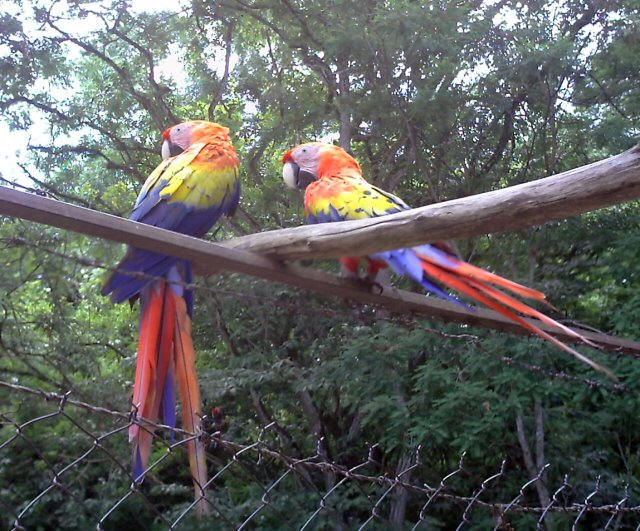
COPAN RUINAS: The path to the ruins meanders along 400 meters through a lovely landscaped jungle setting, finally arriving at the gate manned by armed national police personnel. Wild parrots help watch the entrance gate.
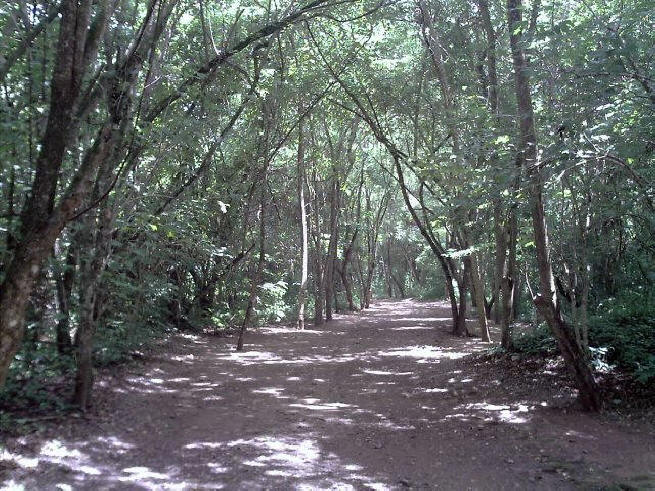
Coppan Ruinas Honduras: Mosquito ally through the Las Sepulturas archaeological ruins area.
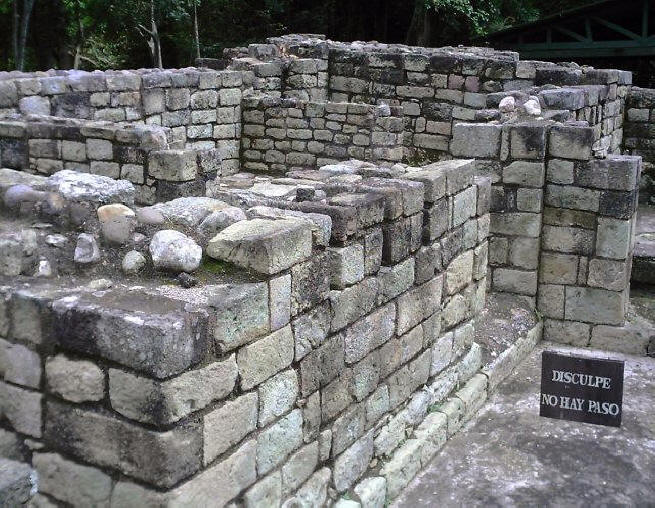
Coppan Ruinas Honduras: One of the structures in the Las Sepulturas archaeological ruins area.

Coppan Ruinas Honduras: One of the structures in the Las Sepulturas archaeological ruins area.

Coppan Ruinas Honduras: One of the structures in the Las Sepulturas archaeological ruins area.
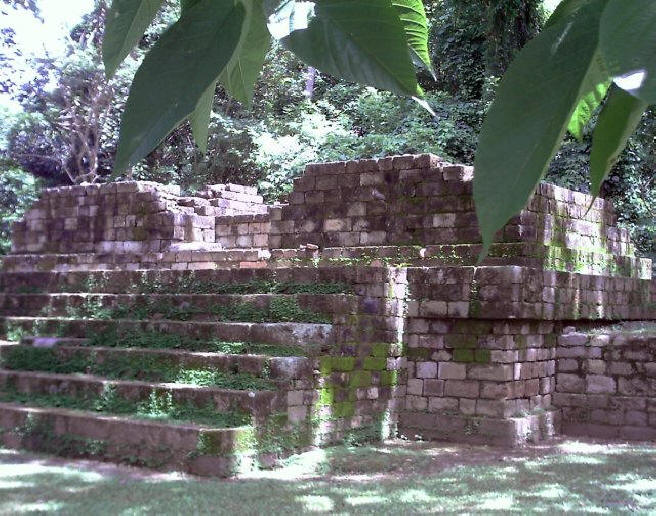
Coppan Ruinas Honduras: One of the structures in the Las Sepulturas archaeological ruins area.

Coppan Ruinas Honduras: One of the structures in the Las Sepulturas
archaeological ruins area.
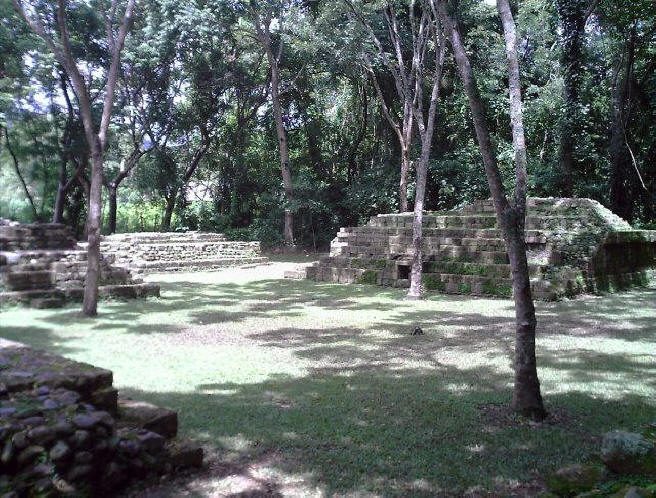
Coppan Ruinas Honduras: Mosquito ally through the Las Sepulturas
archaeological ruins area.
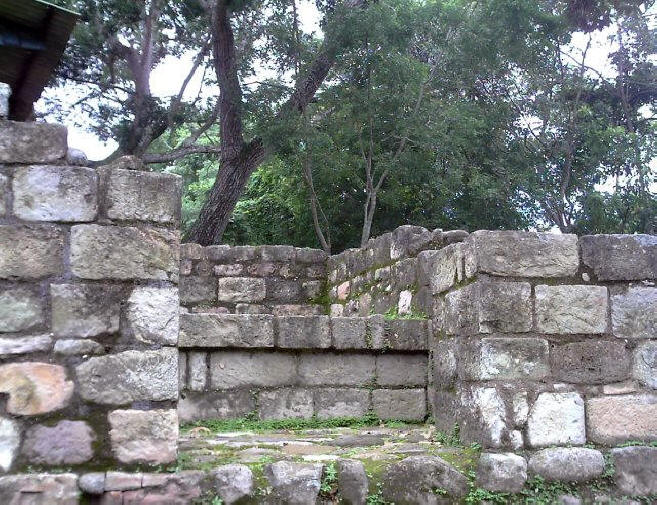
Coppan Ruinas Honduras: One of the structures in the Las Sepulturas
archaeological ruins area. 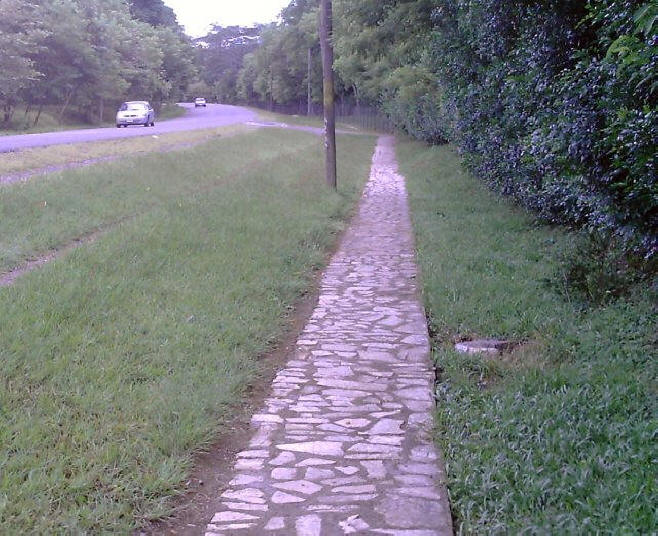
COPAN RUINAS: This is the paved foot path that connects the town to the archaeological park about a mile away... a very pleasant stroll through green pastures and shady trees.

COPAN RUINAS: This is the paved foot path that connects the town to the archaeological park about a mile away... a very pleasant stroll through green pastures and shady trees.
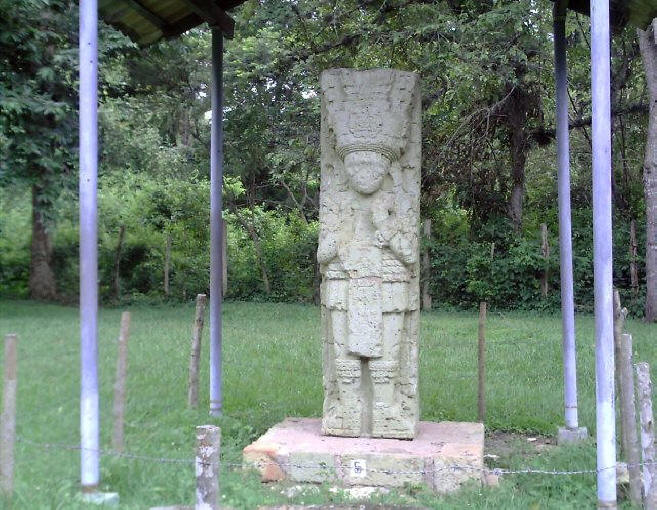
COPAN RUINAS: Along the paved foot path there are several estela like this as well as many unexcavated mounds covering more ruins.
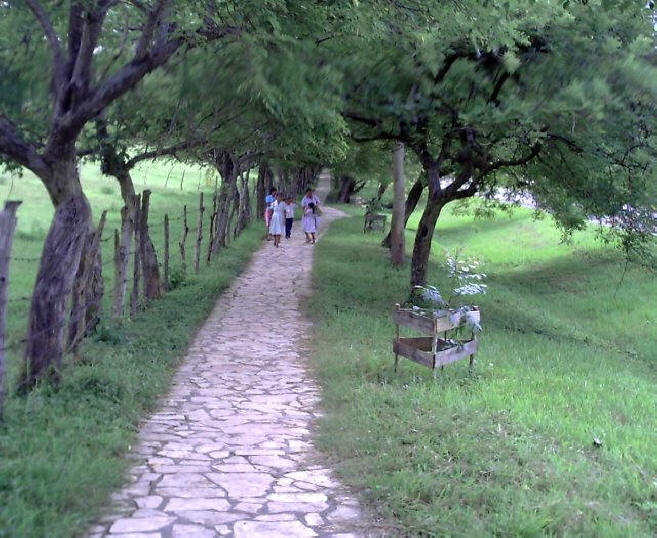
COPAN RUINAS: This is the paved foot path that connects the town to the archaeological park about a mile away... a very pleasant stroll through green pastures and shady trees.
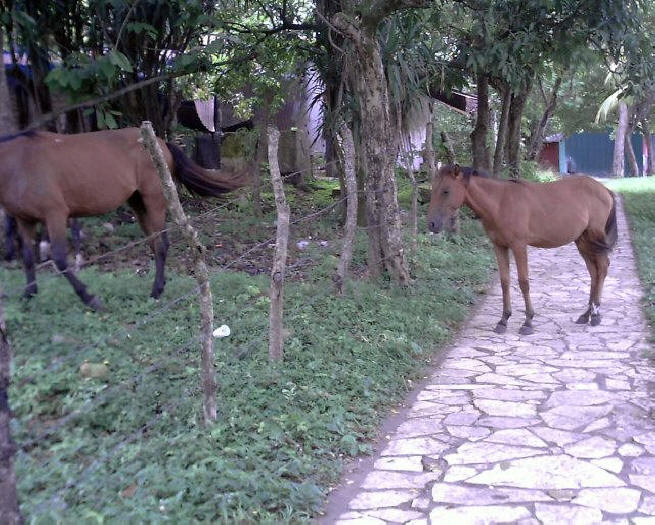
COPAN RUINAS: This is the paved foot path that connects the town to the archaeological park about a mile away... a very pleasant stroll through green pastures and shady trees. One of the others using the path.
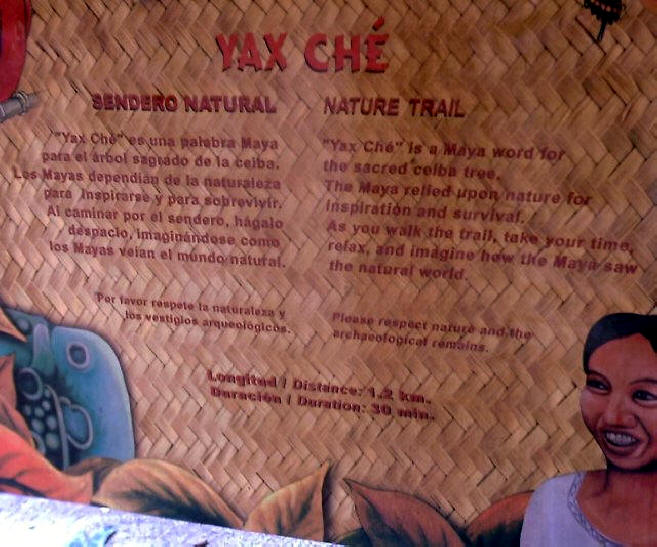
COPAN RUINAS: Information posted near the entrance.
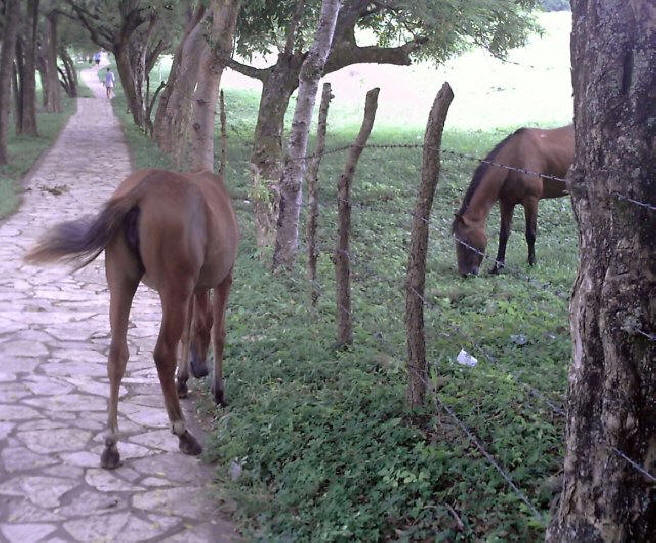
COPAN RUINAS: This is the paved foot path that connects the town to the archaeological park about a mile away... a very pleasant stroll through green pastures and shady trees. One of the others using the path.
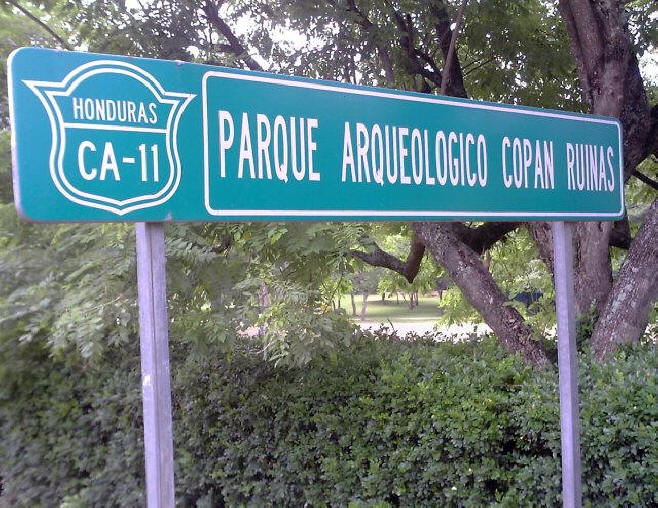
COPAN RUINAS: Road sign announcing the archaeological park.
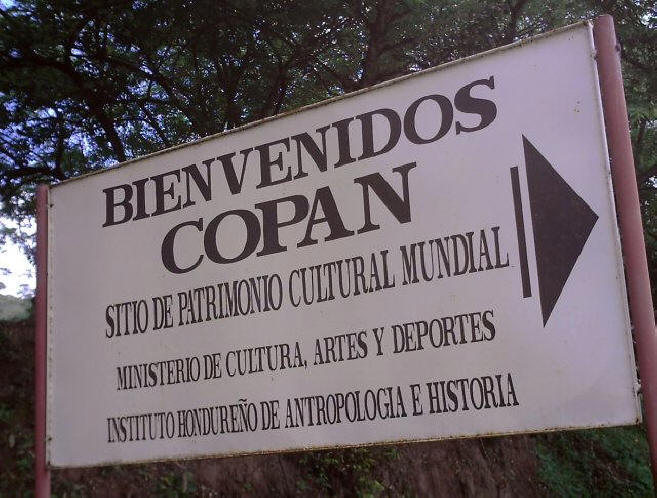
COPAN RUINAS: Road sign announcing the archaeological park headquarters.
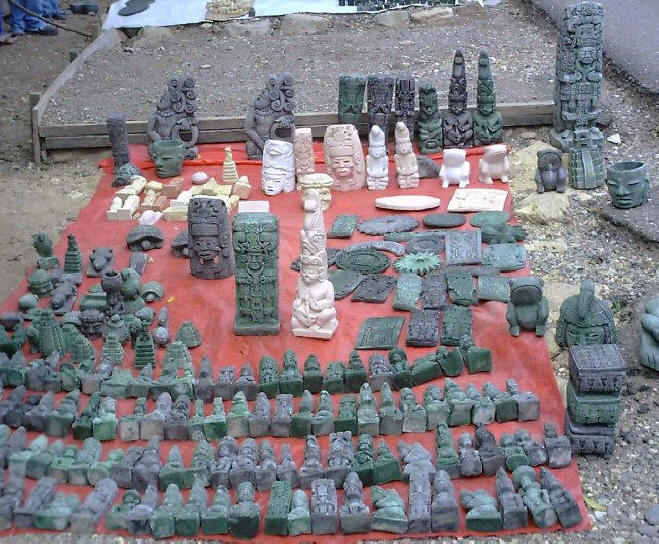
COPAN RUINAS: Display of things being offered by vendors at the entrance to the archaeological park.
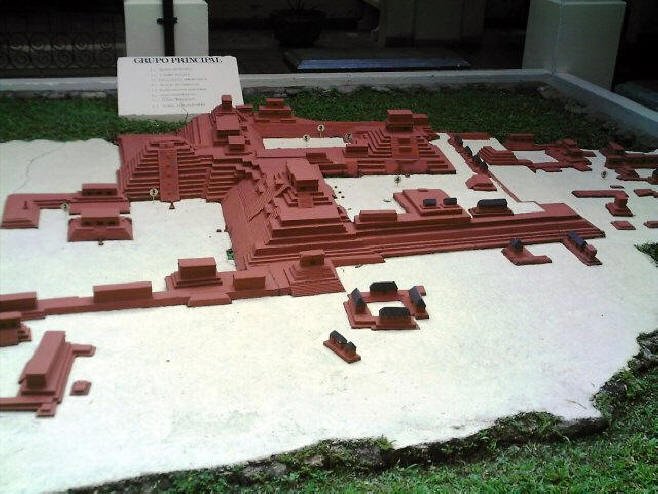
COPAN RUINAS: Miniature display of the layout of the ruins. It is located near the ticket sellers booth. Another angle.
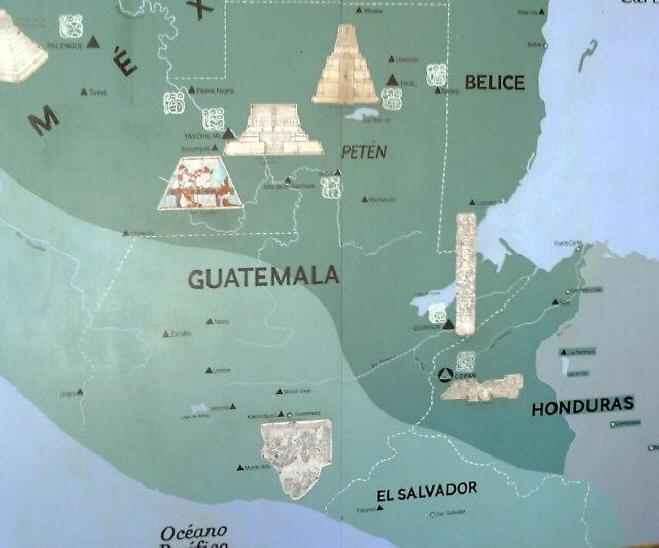
COPAN RUINAS: Map showing the locations of mayan ruins throughout Central America.
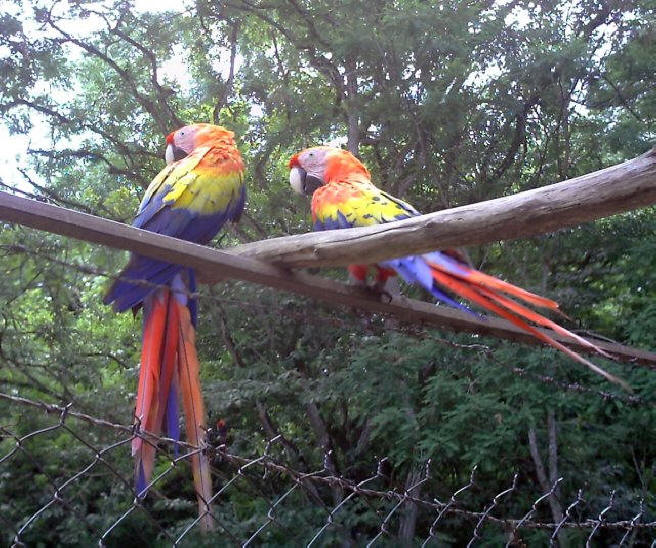
COPAN RUINAS: The path to the ruins meanders along 400 meters through a lovely landscaped jungle setting, finally arriving at the gate manned by armed national police personnel. Wild parrots help watch the entrance gate.
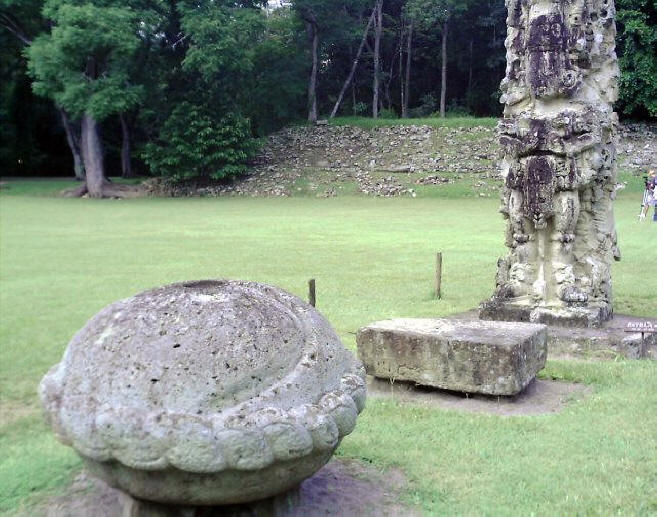
COPAN RUINAS: That round object is an alter on which victims were sacrificed. Note the spiral channels for draining the blood! One of the major stelae in the main section of Copan Ruinas.
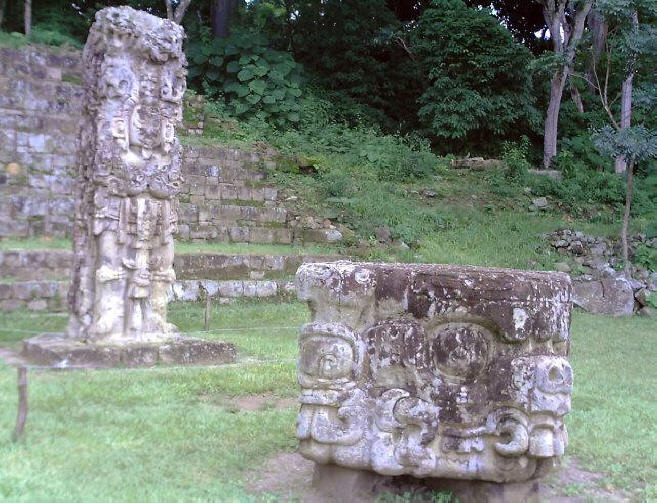
COPAN RUINAS: One of the major stelae in the main section of Copan Ruinas.
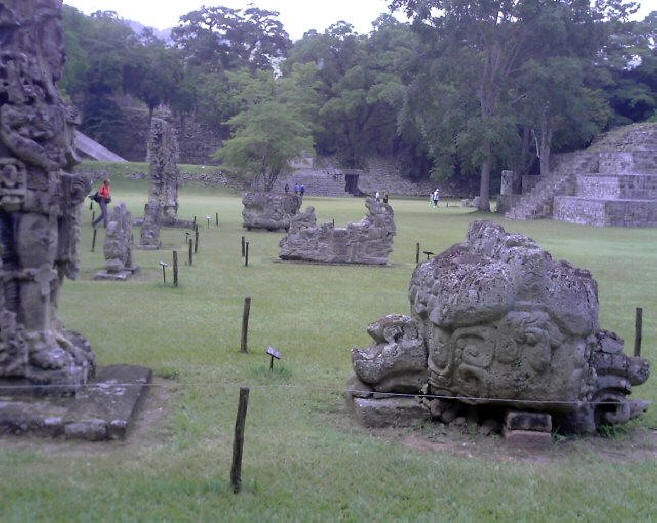
COPAN RUINAS: Group of sculptures and stelae in the main section of Copan Ruinas.
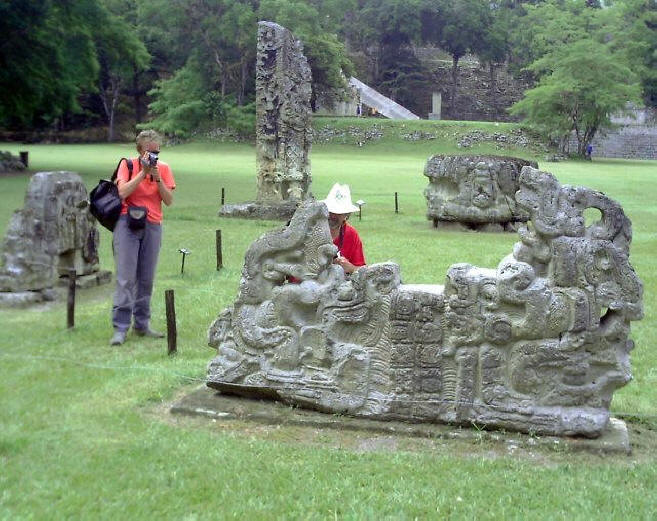
COPAN RUINAS: Altar G1 in the main section of Copan Ruinas.
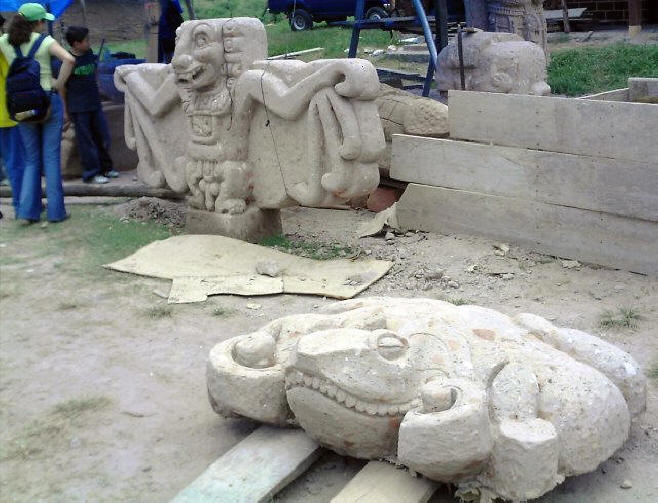
COPAN RUINAS: This stone sculpture workshop sits across the street from the entrance to the main archaeological park. Here we see some of the finished works for sale.
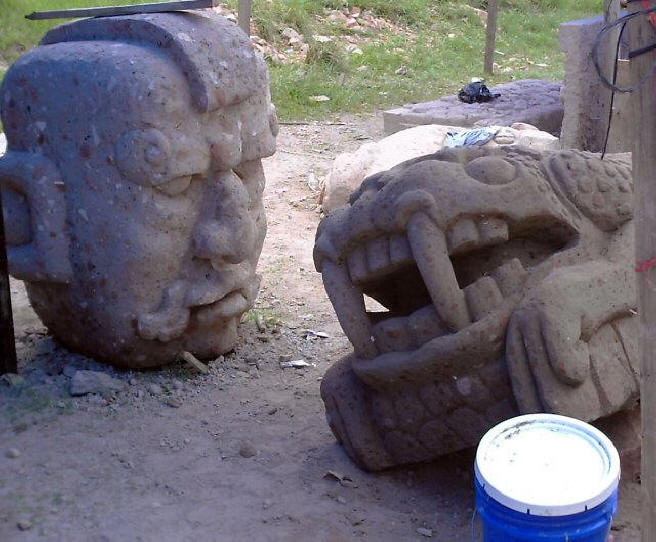
COPAN RUINAS: This stone sculpture workshop sits across the street from the entrance to the main archaeological park. Here we see some of the finished works for sale.
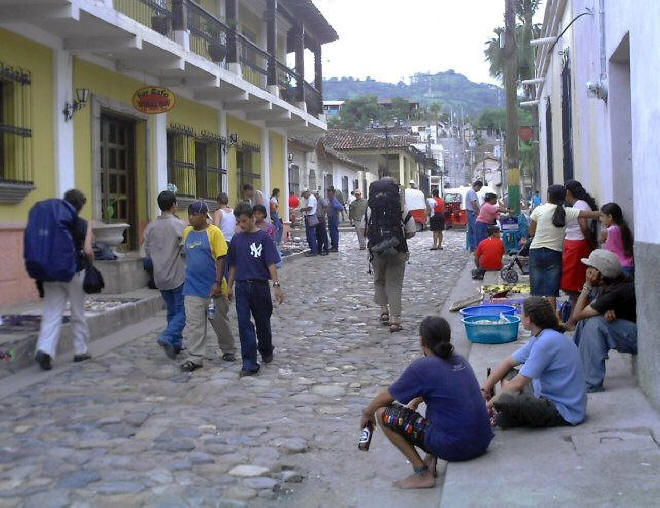
COPAN RUINAS: Continuation of the street that runs along the west side of the plaza and the one on which the entrance to the Hotel Marina Copan is located. This block is the main commercial area for tourists and always has sidewalk vendors selling crafts.
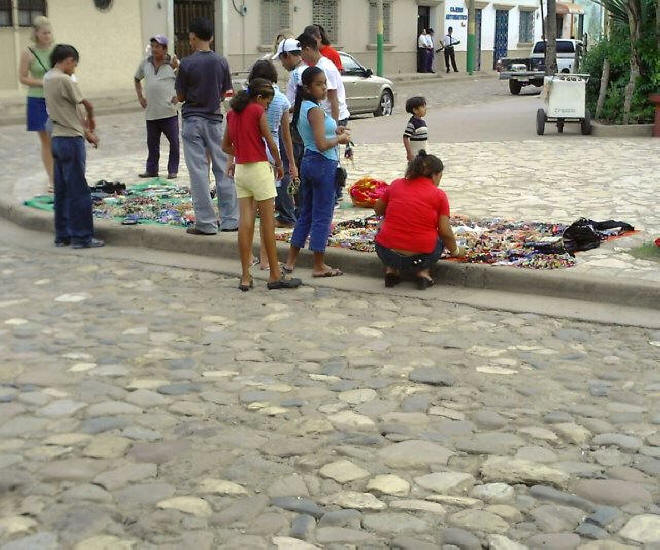
COPAN RUINAS: This is the street that runs along the east side of the plaza. Here too we have sidewalk vendors selling crafts. Notice the cobblestone road paving used throughout the town.
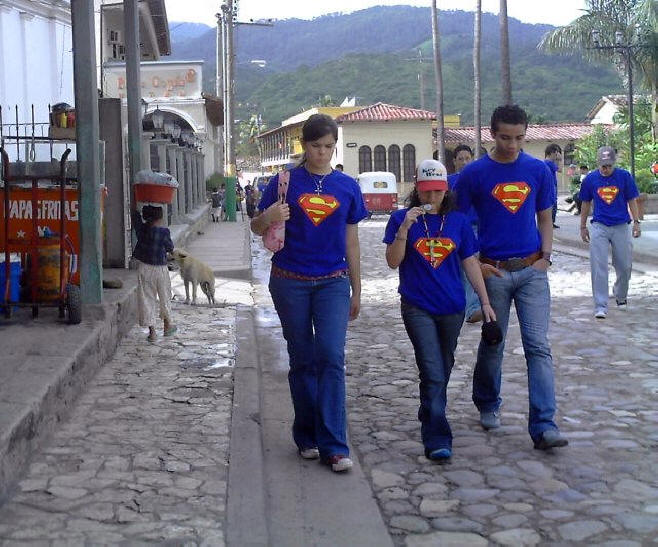
COPAN RUINAS: I am not sure what this group is all about, but about twenty teenagers wearing Superman shirts spent time in town during my stay.
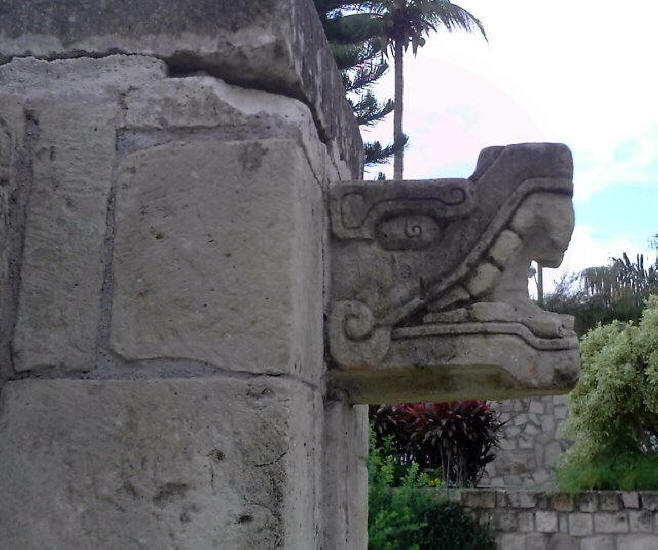
COPAN RUINAS: One of the sculptures in the central Plaza.
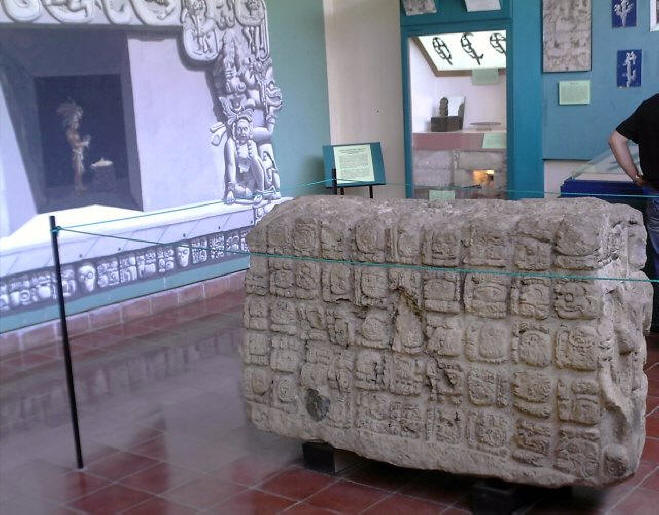
COPAN RUINAS: Sculpture from the near-by ruins on display in the Copan Archaeological Museum in the Parque Central.

COPAN RUINAS: Reproduction of a painting from the near-by ruins on display in the Copan Archaeological Museum in the Parque Central.
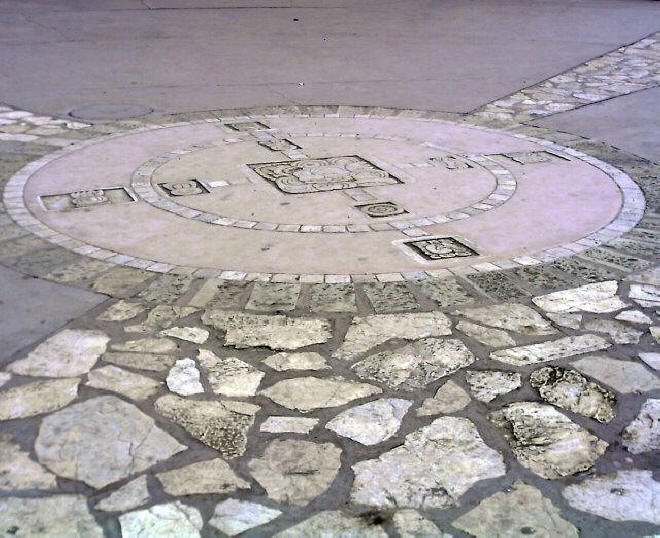
COPAN RUINAS: Design in the paving in the central Plaza.
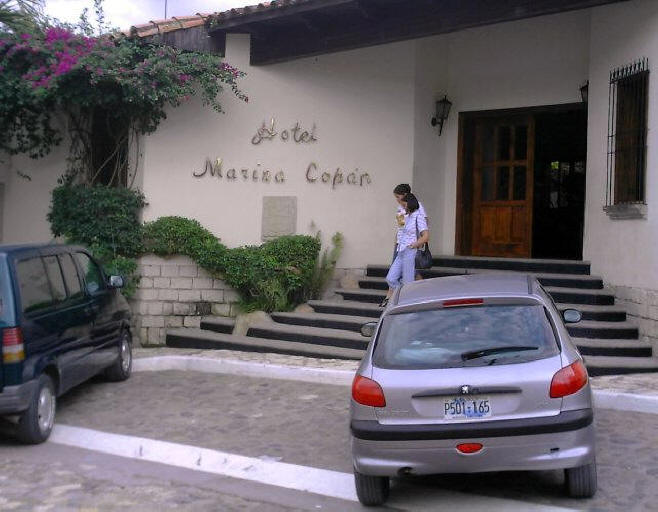
COPAN RUINAS: Entrance to the Hotel Marina Copan, easily the best hotel in town. Most of the rooms give guests the feeling they have stepped back into colonial times. In the new building everything is up to date and modern, except the tile floors.
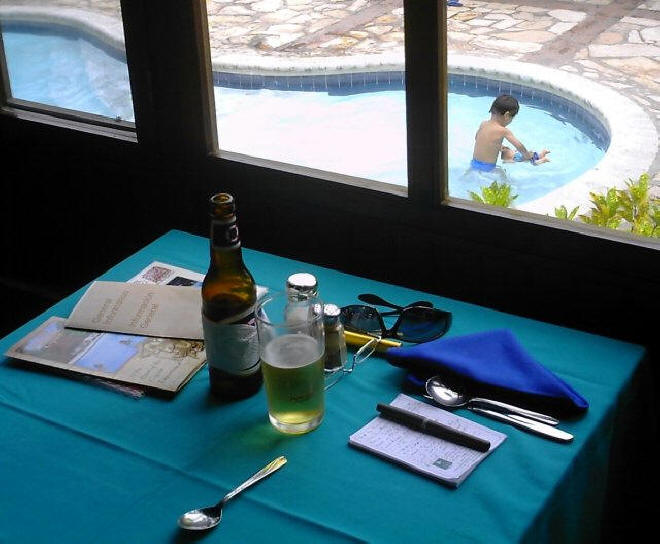
COPAN RUINAS: The pool area from my table in the restaurant at the Hotel Marina Copan.
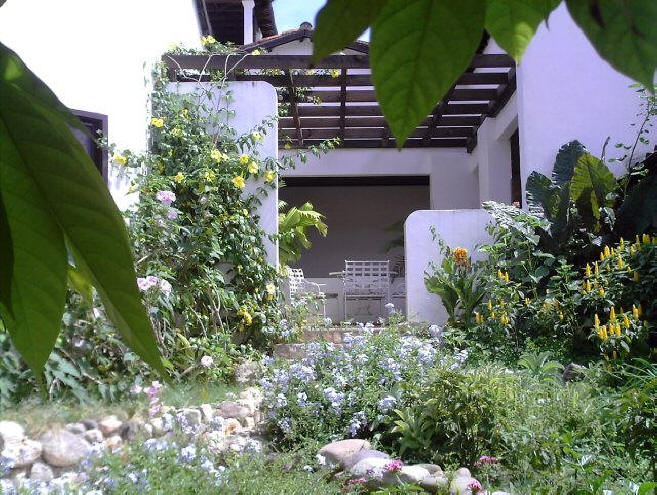
COPAN RUINAS: Another view of the landscaping around the Hotel Marina Copan.
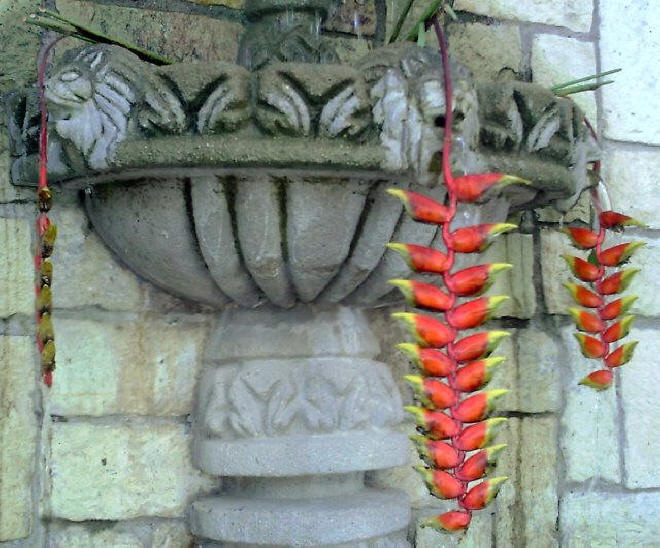
COPAN RUINAS: One of the gorgeous floral displays at the Hotel Marina Copan.

COPAN RUINAS: A view of a landscaped area at the Hotel Marina Copan.
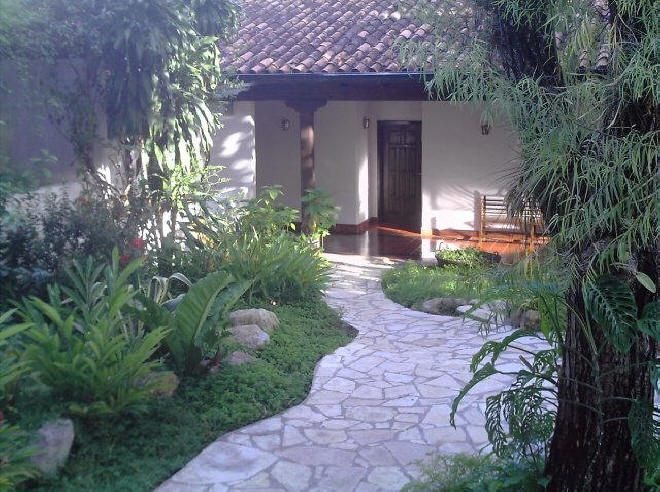
COPAN RUINAS: A view of a landscaped area at the Hotel Marina Copan.
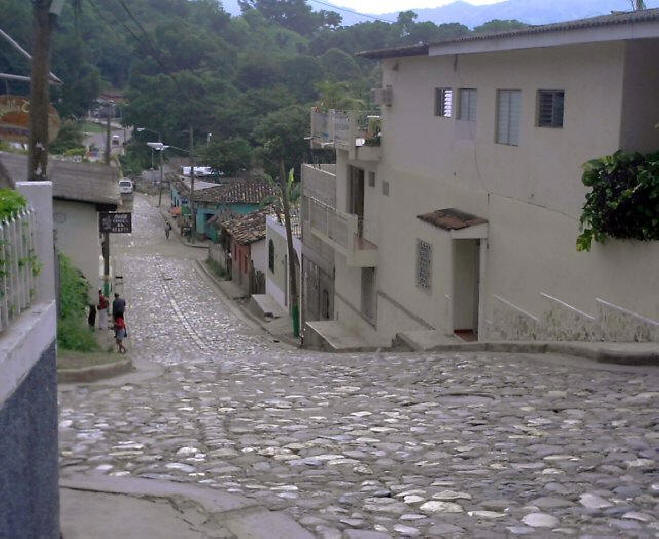
COPAN RUINAS: Half of the paved streets in town are so steep one needs four wheel drive to make the grade.
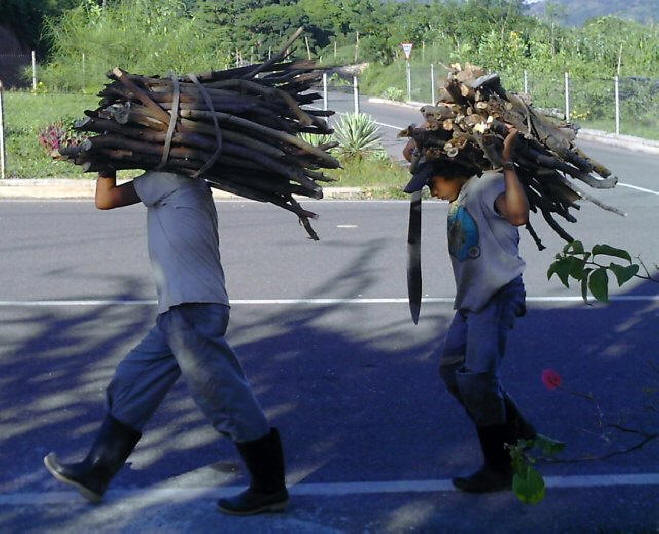
COPAN RUINAS: Young husky wood cutters on their way home. Notice the machete. Most men carry them.
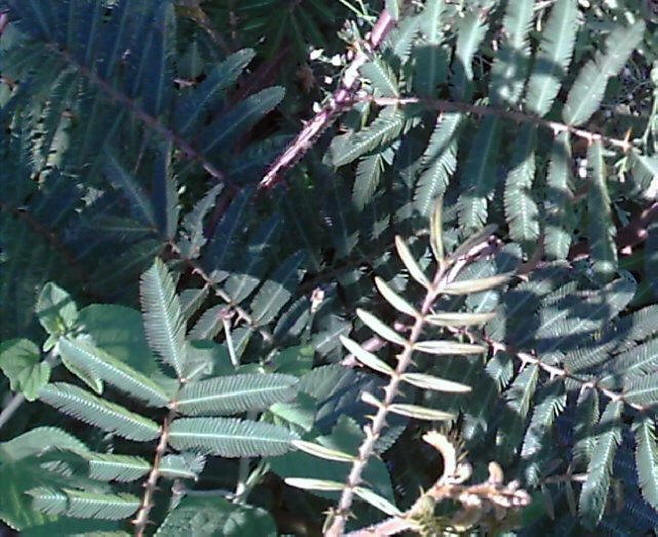
COPAN RUINAS: Close up of SARSA plants growing outside town. The leaves when touched, shrivel up.

COPAN RUINAS: Close up of SARSA plants growing outside town. The leaves when touched, shrivel up.

COPAN RUINAS: Outside the city looking northwest toward the center of town.
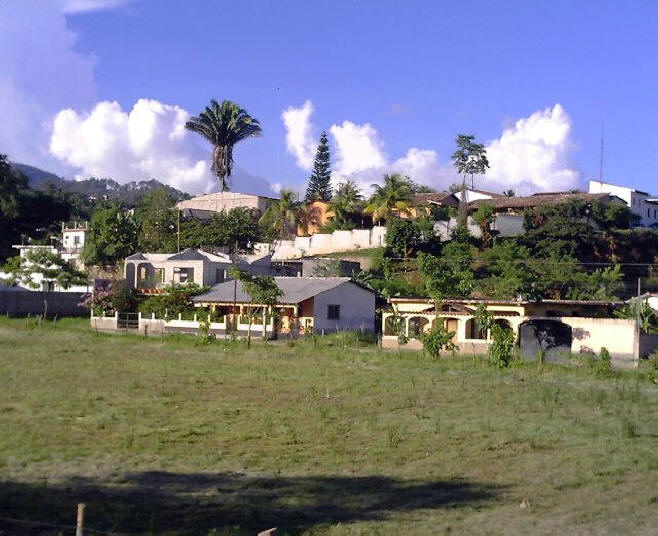
COPAN RUINAS: Outside the city looking northwest toward the center of town.
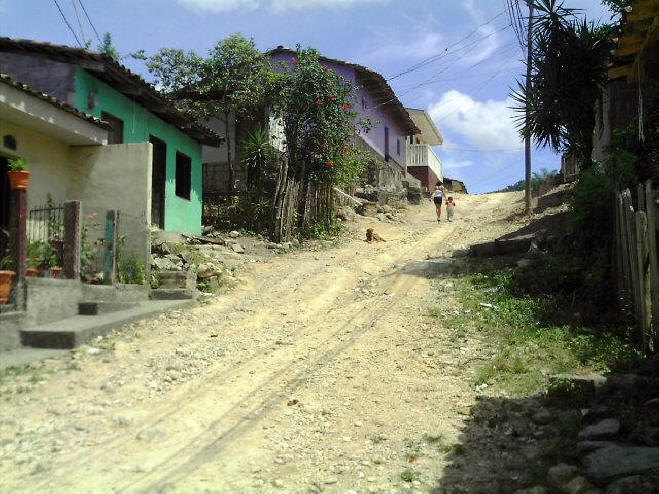
COPAN RUINAS: Many of the streets away from the central district remain unpaved like this one. Some in this hilly town are so steep few ordinary cars would be able to climb them.
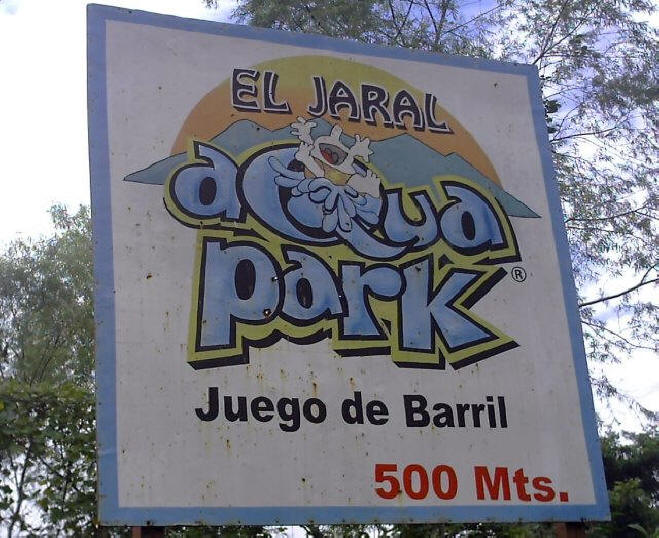
COPAN RUINAS: Road sign announcing the water park, El Jaral.
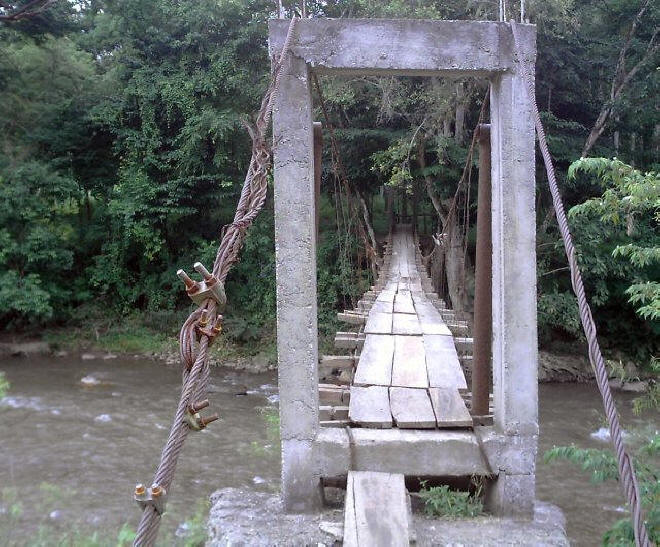
COPAN RUINAS: Hanging foot bridge across a river near the El Jaral water park and "mall."
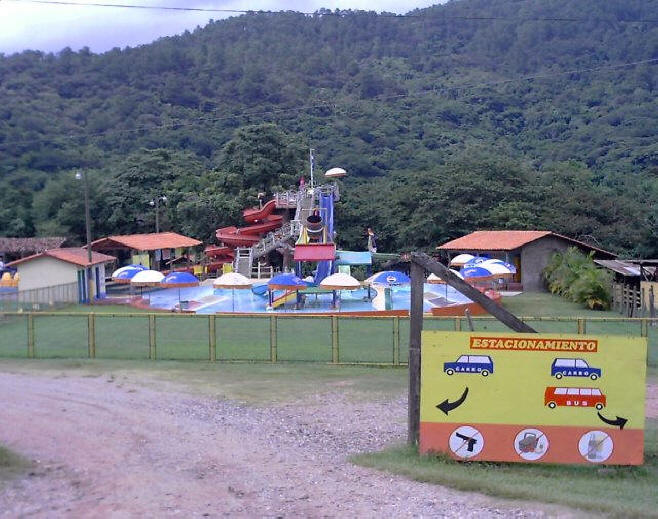
COPAN RUINAS: In the city proper there is nothing remotely resembling a modern shopping shopping area. So, my ears perked up when I heard rumors of a "shopping mall" not more than 8km from town, El Jaral. This is it! A water park with an adjacent "mall" containing six shops catering to the interests of tourists... half of them closed, and two refreshment stands where the girls spent all their time chatting with one another, ignoring the lone potential customer in the building.
|
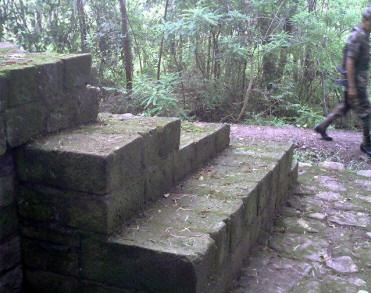
Coppan Ruinas Honduras: Details of
one of the structures in the Las Sepulturas archaeological ruins area.
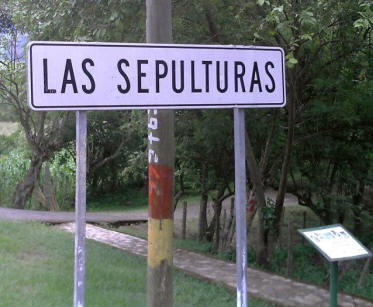
Coppan Ruinas Honduras: Highway sign near the entrance to the Las Sepulturas
archaeological ruins area.
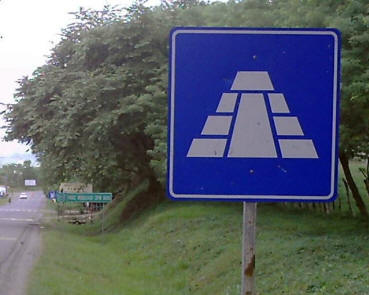
Coppan Ruinas Honduras: Highway sign near the entrance to the Las Sepulturas
archaeological ruins area.
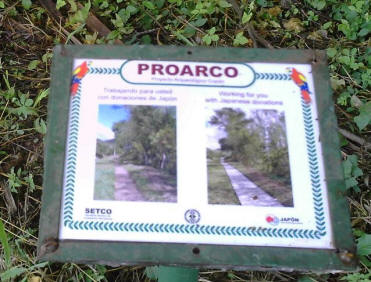
Coppan Ruinas Honduras: Sign along the foot path near the entrance to the
Las Sepulturas archaeological ruins area.
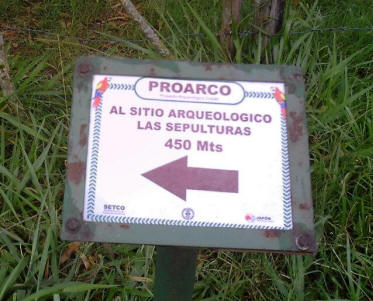
Coppan Ruinas Honduras: Sign along the foot path near the entrance to the
Las Sepulturas archaeological ruins area.
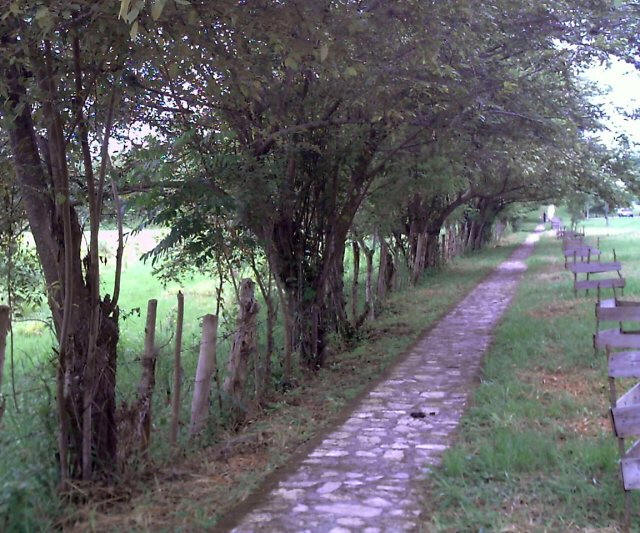
Coppan Ruinas Honduras: The foot path near the entrance to the Las
Sepulturas archaeological ruins area.

Coppan Ruinas Honduras: The foot path through the Las Sepulturas
archaeological ruins area.
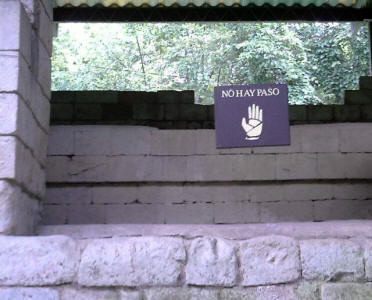
Coppan Ruinas Honduras: Some places are out of bounds in the Las Sepulturas
archaeological ruins area.
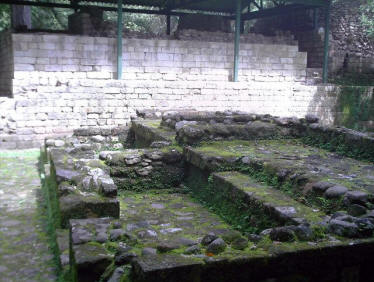
Coppan Ruinas Honduras: One of the structures in the Las Sepulturas
archaeological ruins area.
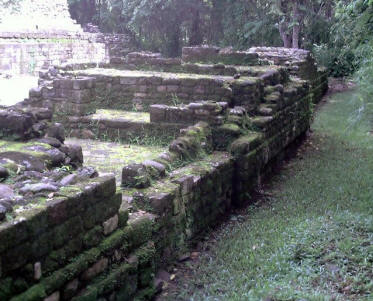
Coppan Ruinas Honduras: One of the structures in the Las Sepulturas
archaeological ruins area.
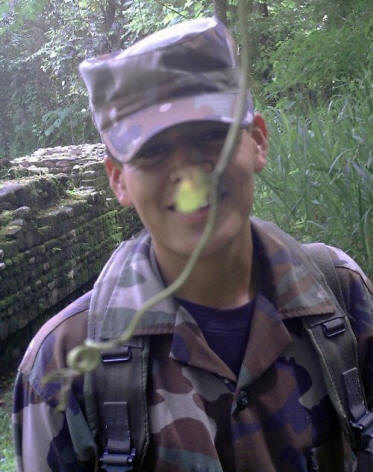
Coppan Ruinas Honduras: Security guard watching tourists at the Las
Sepulturas archaeological ruins area.

Coppan Ruinas Honduras: One of the structures in the Las Sepulturas
archaeological ruins area.

Coppan Ruinas Honduras: One of the structures in the Las Sepulturas
archaeological ruins area.
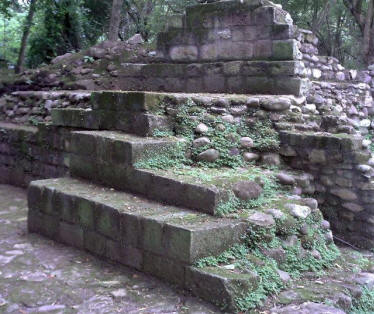
Coppan Ruinas Honduras: One of the structures in the Las Sepulturas
archaeological ruins area.
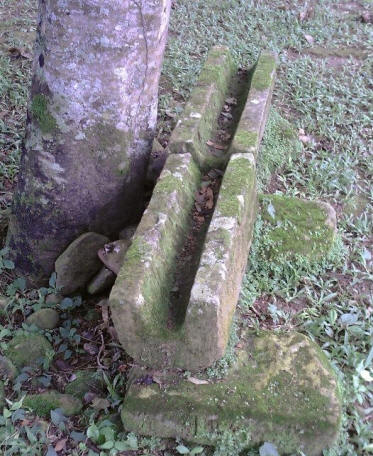
Coppan Ruinas Honduras: One of the structures in the Las Sepulturas
archaeological ruins area.
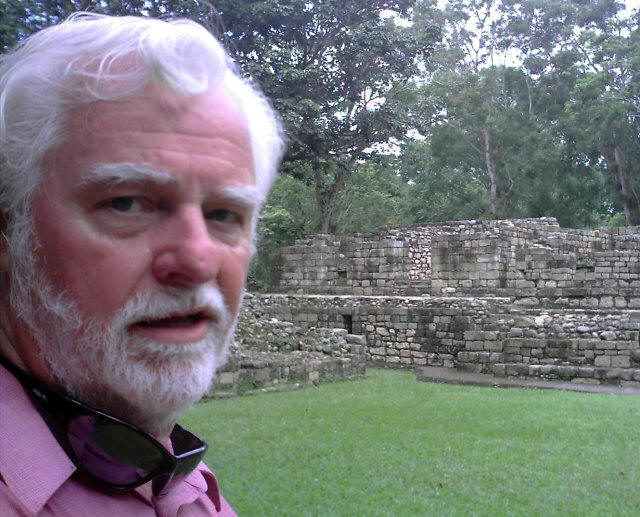
Coppan Ruinas Honduras: Author in front of a structure in the Las
Sepulturas archaeological ruins area.
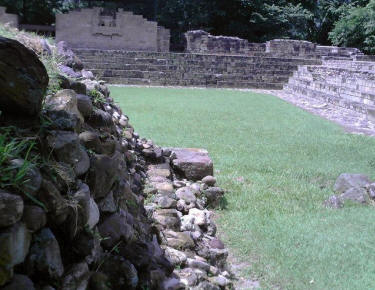
Coppan Ruinas Honduras: One of the structures in the Las Sepulturas
archaeological ruins area.
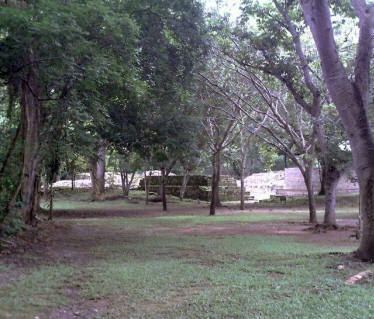
Coppan Ruinas Honduras: Mosquito ally through the Las Sepulturas
archaeological ruins area.

Coppan Ruinas Honduras: One of the structures in the Las Sepulturas
archaeological ruins area.
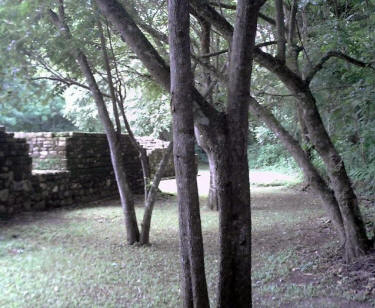
Coppan Ruinas Honduras: One of the structures in the Las Sepulturas
archaeological ruins area.
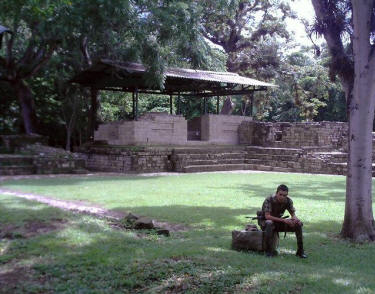
Coppan Ruinas Honduras: Security guard watching tourists at the Las
Sepulturas archaeological ruins area.
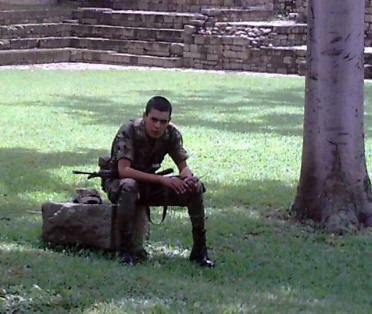
Coppan Ruinas Honduras: Security guard watching tourists at the Las
Sepulturas archaeological ruins area.
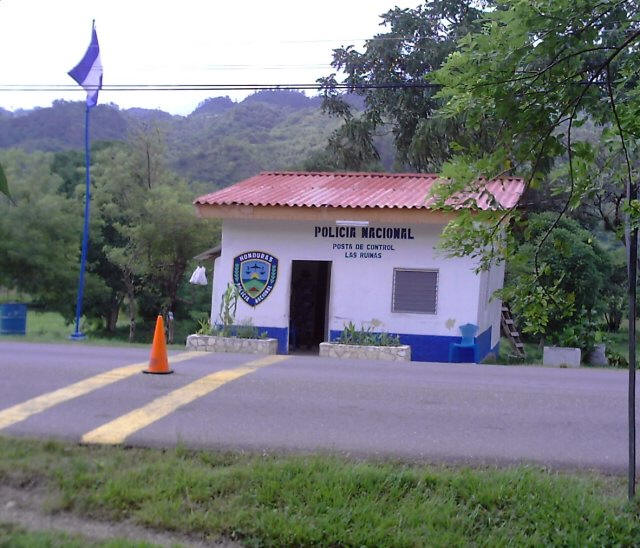
COPAN RUINAS: Police checkpoint along the road and foot path leading to
the archaeological park. Police stopped all cars except for the
recognized regulars.
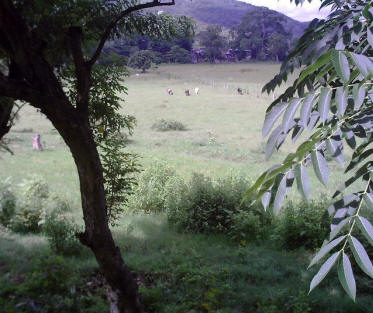
COPAN RUINAS: Along the paved foot path that connects the town to the
archaeological park about a mile away I enjoyed a very pleasant stroll
through green pastures and shady trees like this.
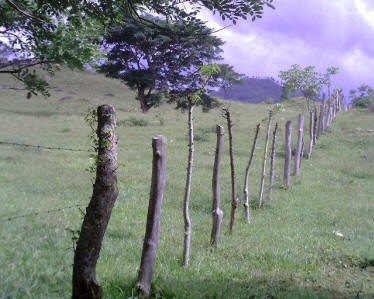
COPAN RUINAS: This area of the world is so furtile even fence posts take
root and grow. During bus rides I saw long rows of trees I assumed had
been planted on property lines. In fact, they may have been fence posts
that sprouted.
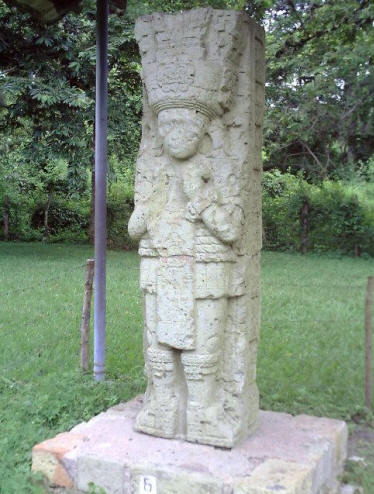
COPAN RUINAS: Along the paved foot path there are several estela like
this as well as many unexcavated mounds covering more ruins.
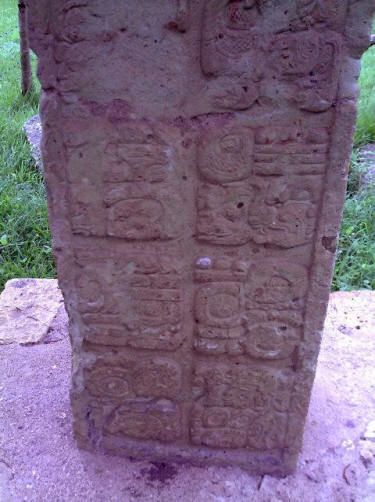
COPAN RUINAS: Along the paved foot path there are several estela like
this as well as many unexcavated mounds covering more ruins.
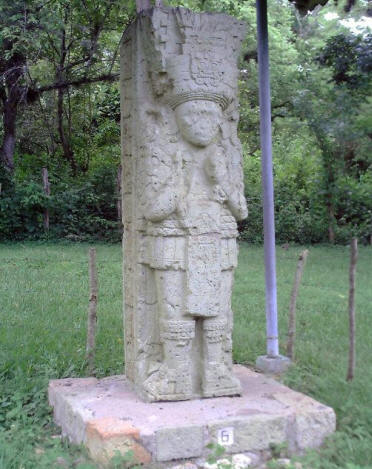
COPAN RUINAS: Along the paved foot path there are several estela like
this as well as many unexcavated mounds covering more ruins.
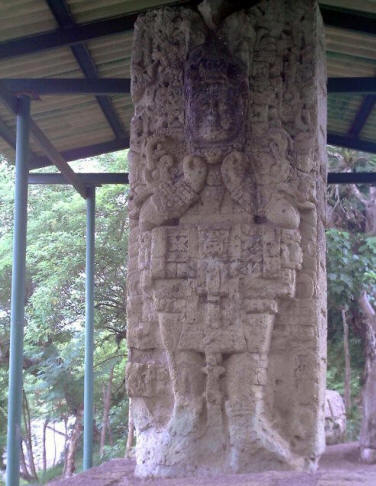
COPAN RUINAS: Along the paved foot path there are several estela like
this as well as many unexcavated mounds covering more ruins.
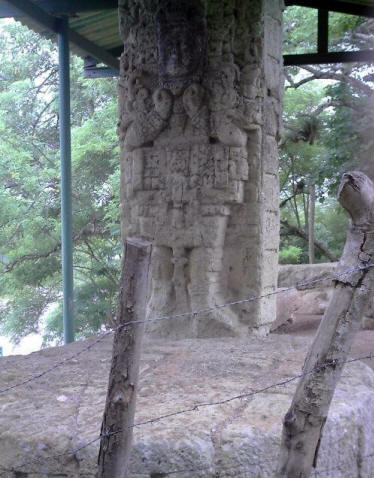
COPAN RUINAS: Along the paved foot path there are several estela like
this as well as many unexcavated mounds covering more ruins.
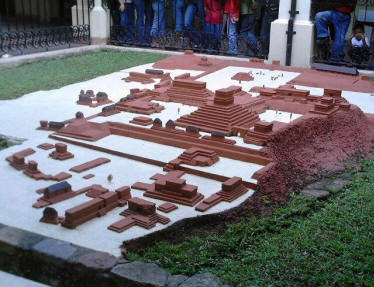
COPAN RUINAS: Miniature display of the layout of the ruins. It is
located near the ticket sellers booth. Another angle.
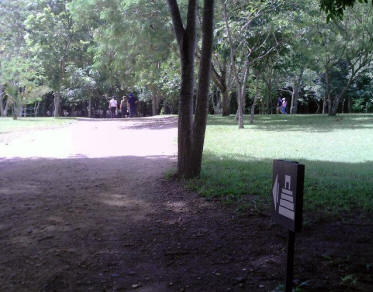
COPAN RUINAS: The landscaped path begins immediately outside the
entrance building.
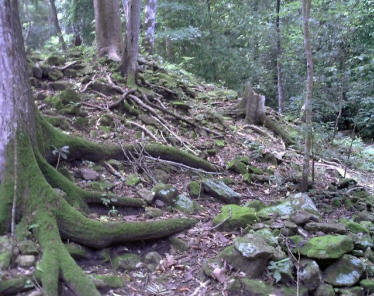
COPAN RUINAS: This is what the archaeologists saw over much of the area
when they first arrived.
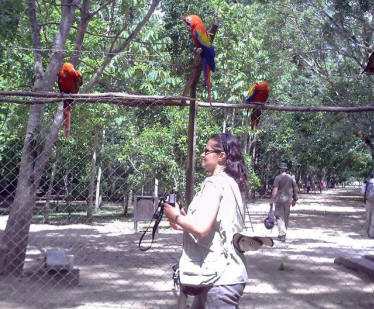
COPAN RUINAS: The path to the ruins meanders along 400 meters through a
lovely landscaped jungle setting, finally arriving at the gate where
these wild parrots watch the ticket takers.
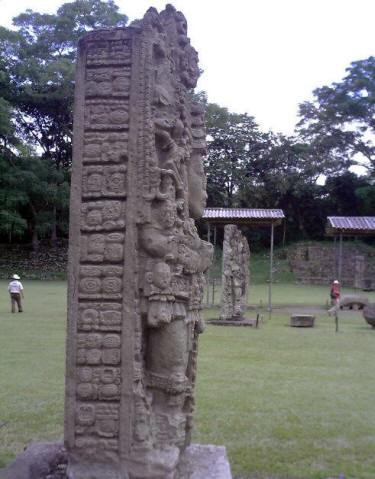
COPAN RUINAS: One of the major stelae in the main section of Copan
Ruinas.
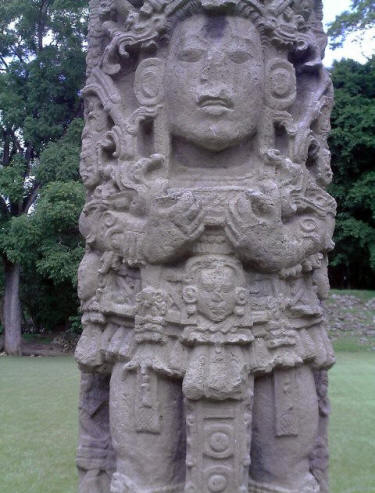
COPAN RUINAS: Details of one of the major stelae in the main section of
Copan Ruinas.
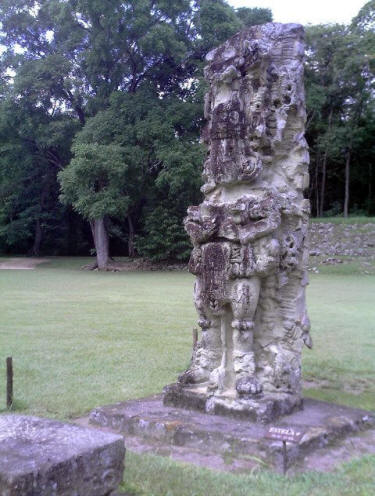
COPAN RUINAS: One of the major stelae in the main section of Copan
Ruinas.
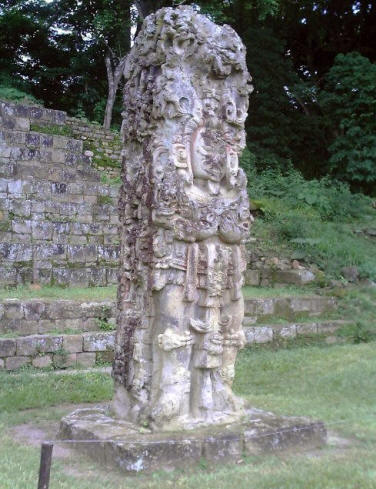
COPAN RUINAS: One of the major stelae in the main section of Copan
Ruinas.

COPAN RUINAS: Details of a stelae in the main section of Copan Ruinas.
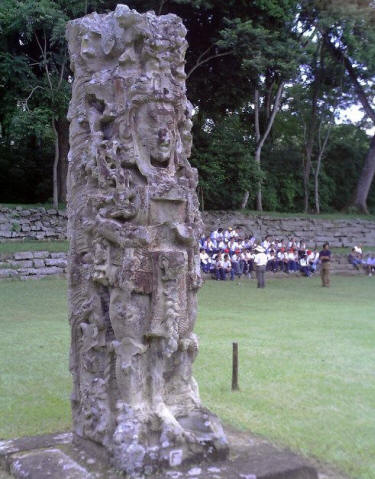
COPAN RUINAS: One of the major stelae in the main section of Copan
Ruinas.

COPAN RUINAS: One of the major stelae in the main section of Copan
Ruinas.
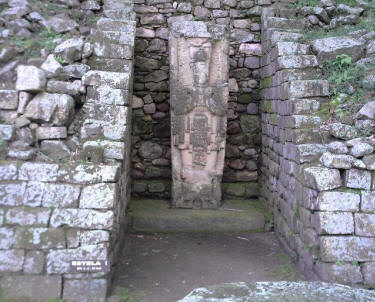
COPAN RUINAS: One of the major stelae in the main section of Copan
Ruinas.
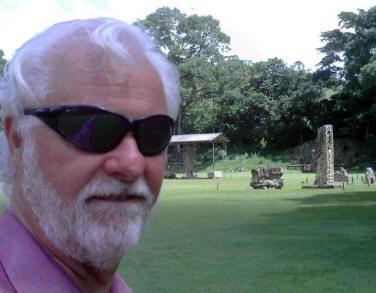
COPAN RUINAS: Some guy wanted a photo to prove he had actually been
here.
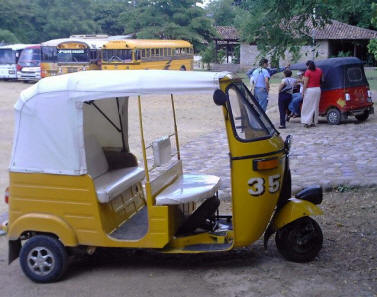
COPAN RUINAS: This is one of the flock of MOTOTAXIS that wait for
passengers returning to hotels in the town. Fare is usually 10 Lempiras
to anywhere in town.
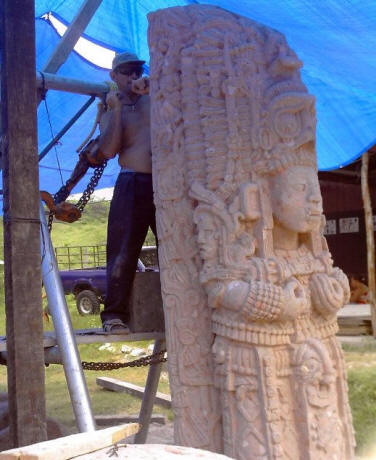
COPAN RUINAS: This stone sculpture workshop sits across the street from
the entrance to the main archaeological park. Here we see one of the
artists at work.
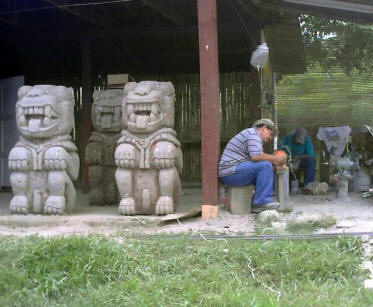
COPAN RUINAS: This stone sculpture workshop sits across the street from
the entrance to the main archaeological park. Here we see some of the
finished works for sale.
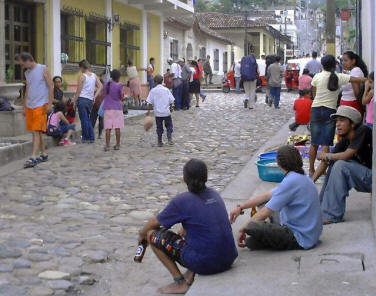
COPAN RUINAS: Continuation of the street that runs along the west side
of the plaza. This block is the main commercial area for tourists and
always has sidewalk vendors selling crafts and locals who seem to enjoy
watching the tourists.
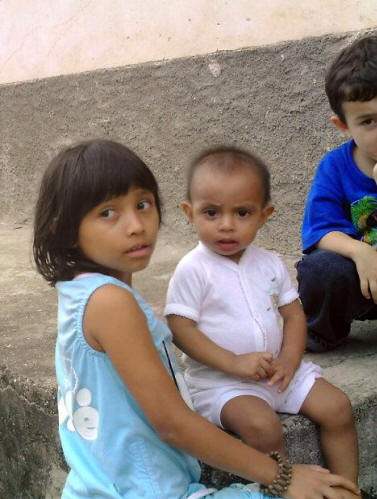
COPAN RUINAS: Two cute kids watched me taking photos, so I took one of
them.
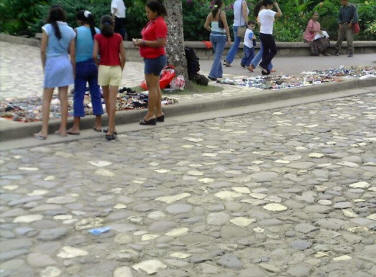
COPAN RUINAS: This is the street that runs along the east side of the
plaza. Here too we have sidewalk vendors selling crafts. Notice the
cobblestone road paving used throughout the town.
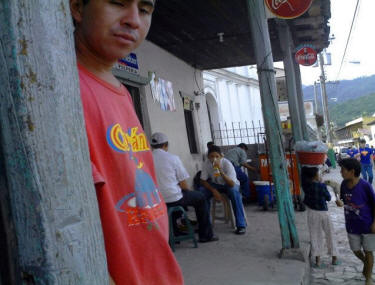
COPAN RUINAS: This kid got curious so I shot him... he survived the
assult.
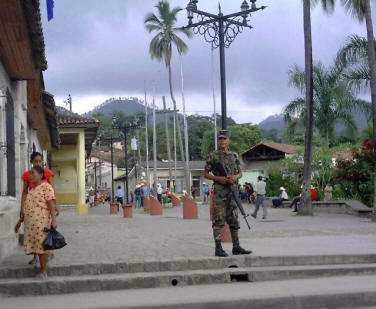
COPAN RUINAS: Armed National Policeman guards the central Plaza.
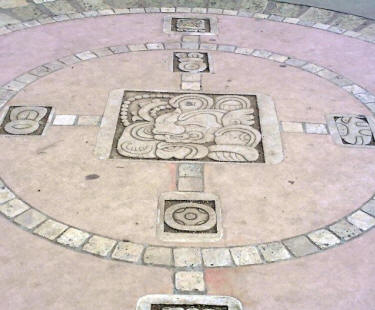
COPAN RUINAS: Design in the paving in the central Plaza.
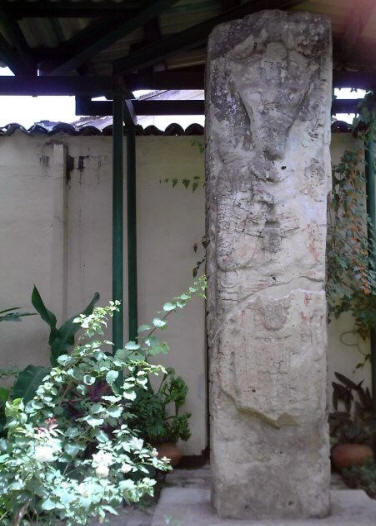
COPAN RUINAS: The Copan Archaeological Museum sits on the west side of
the central plaza. This large
stelae has been brought to the museum from the ruins for safe
keeping.
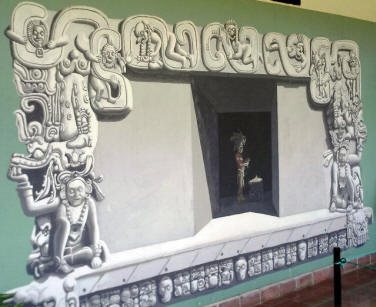
COPAN RUINAS: Sculpture from the near-by ruins on display in the Copan
Archaeological Museum in the Parque Central.

COPAN RUINAS: The Copan Cathedral sits along the eastern side of the
central plaza, Parque Central.

COPAN RUINAS: This reproduction of a bas relief found in the nearby
ruins decorates one of the hotels near the plaza.
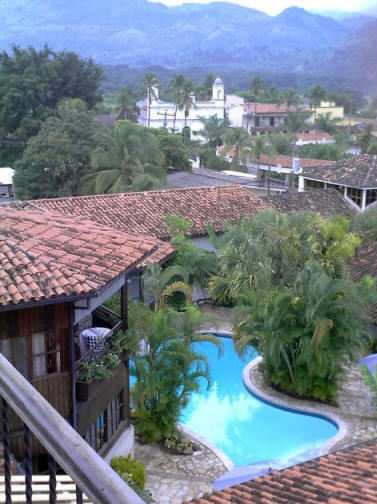
COPAN RUINAS: A view of the pool area at the Hotel Marina Copan.
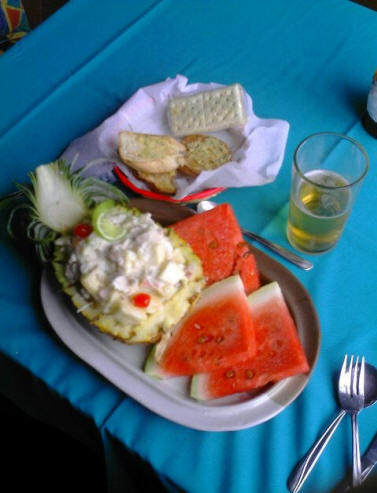
COPAN RUINAS: My first lunch in the restaurant at the Hotel Marina
Copan. This is the Ensalada de Pollo Tropical, a delicious combination
of pineapple chunks, chicken pieces, mushrooms in a slightly sweet
dressing and served in the pineapple shell.
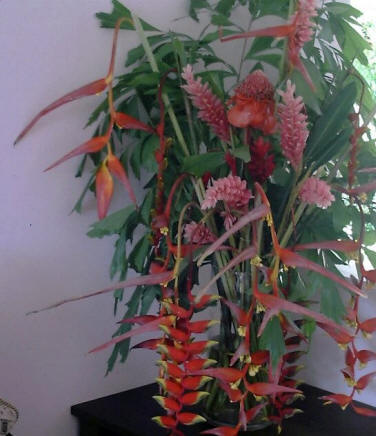
COPAN RUINAS: Another of the gorgeous floral displays at the Hotel
Marina Copan.
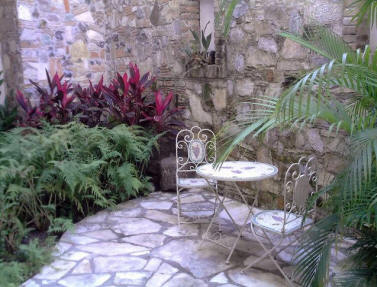
COPAN RUINAS: A view of a landscaped area at the Hotel Marina Copan.

COPAN RUINAS: A view of the pool area at the Hotel Marina Copan.
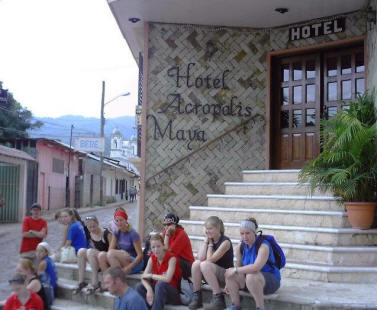
COPAN RUINAS: Entrance to one of the other better value air conditioned
hotels in town, the Hotel Acropolis Maya.
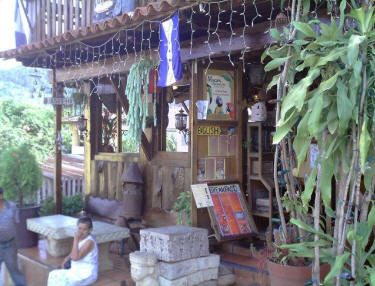
COPAN RUINAS: One of the more popular restaurants in town favored by the
backpacker crowd... and beer drinking smokers!
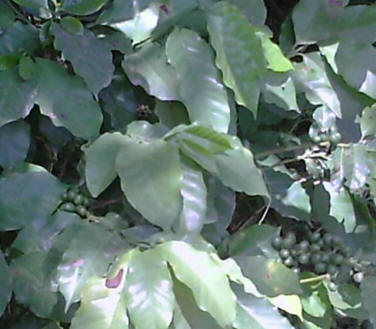
COPAN RUINAS: South of town near the Hedman Alas bus terminal is one of
the coffee plantations. Here we can see some of the green coffee beans
ripening.

COPAN RUINAS: South of town near the Hedman Alas bus terminal is one of
the coffee plantations. Here we can see some of the green coffee beans
ripening.
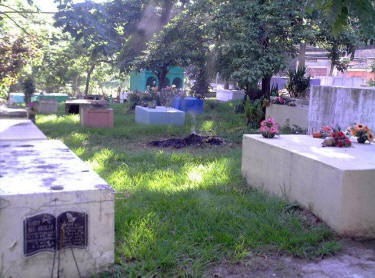
COPAN RUINAS: Low rent district in the main city cemetery.
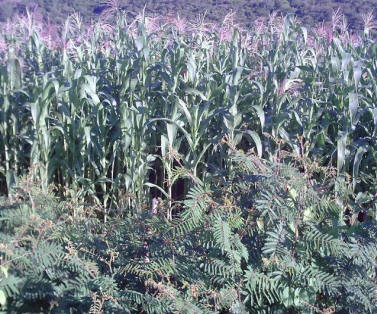
COPAN RUINAS: I found this vigorously growing thicket of SARSA plants
growing outside town near a corn field. A ground cover variety called
Sarsa Dormilona appears identical to a plant I discovered in Malasia and
Indonesia. The leaves when touched, shrivel up.
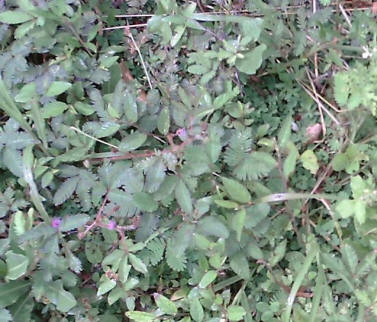
COPAN RUINAS: Another close up of SARSA plants growing outside town. The
leaves when touched, shrivel up.
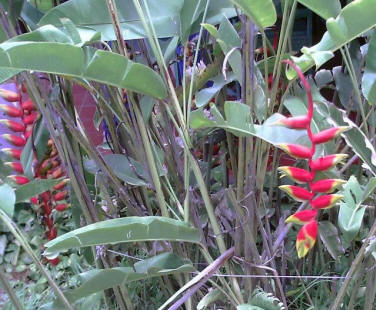
COPAN RUINAS: Interresting flowers(?) growing wild around town.
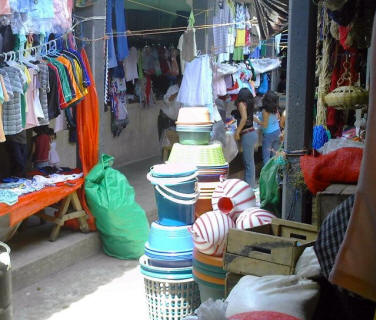
COPAN RUINAS: Inside the Mercado Central behind the west side of the
plaza.
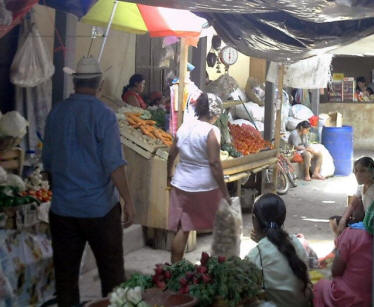
COPAN RUINAS: Inside the Mercado Central behind the west side of the
plaza.
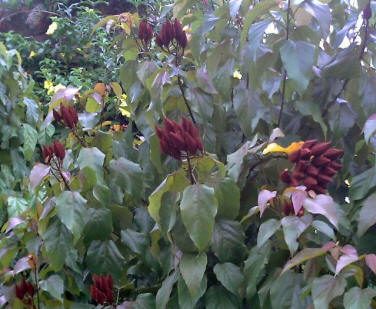
COPAN RUINAS: Some of the unusual plants used to landscape the central
plaza, Parque Central.
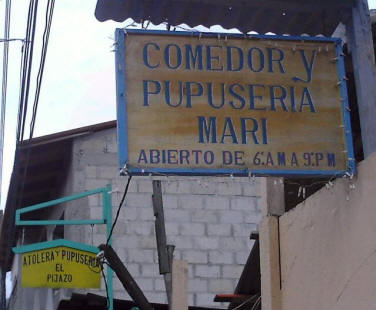
COPAN RUINAS: Sign over a kitchen that makes pupusas, those five inch
diameter thick corn meal patties.
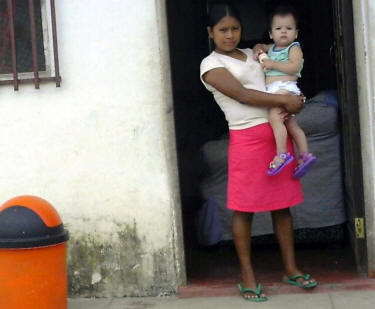
COPAN RUINAS: young girls with babies like this one are common sights
throughout all of Central America. It is easy to see why the region has
one of the highest birth rates in the world.
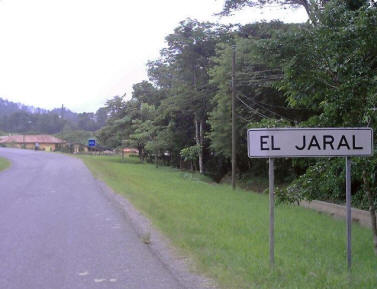
COPAN RUINAS: Road sign announcing the "big" modern shopping mall, El
Jaral. A water park with an adjacent building containing six shops
catering to the interests of tourists... half of them closed. Two
refreshment stands where the girls spent all their time chatting with
one another, ignoring the lone potential customer in the building.
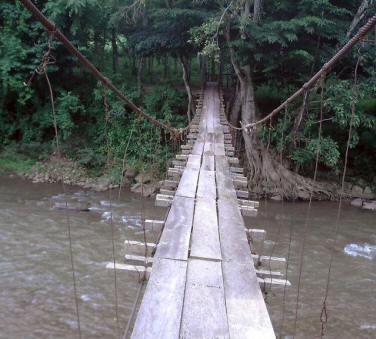
COPAN RUINAS: Hanging foot bridge across a river near the El Jaral water
park and "mall." I stepped out on the unstable boards and decided to
fore go a crossing experience.
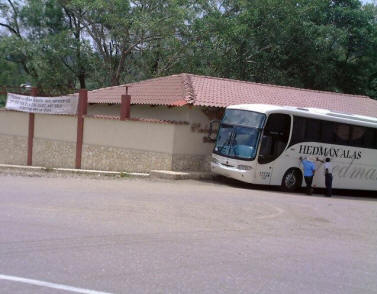
Copan Ruinas: A bus ready to leave the Hedman Alas bus terminal.
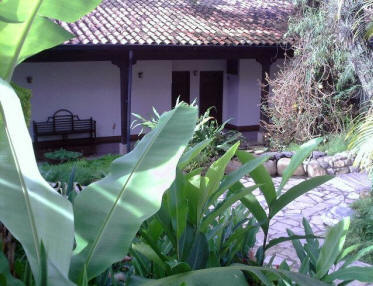
Copan Ruinas: Another shot of the lush landscaping around the grounds of
the Hotel Marina Copan.
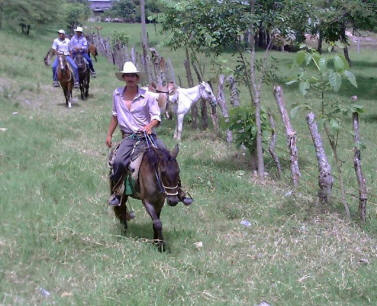
Copan Ruinas: A bunch of cowboys getting ready for work near the Hedman Alas
bus terminal.
|


